May 2014
May 2014 sadmin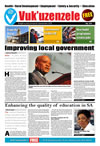
New scholarship helps youth dream big
New scholarship helps youth dream big sadminGovernment will help more than 200 young South Africans realise their dreams by giving them the opportunity to study further through the Solomon Mahlangu Scholarship Fund.
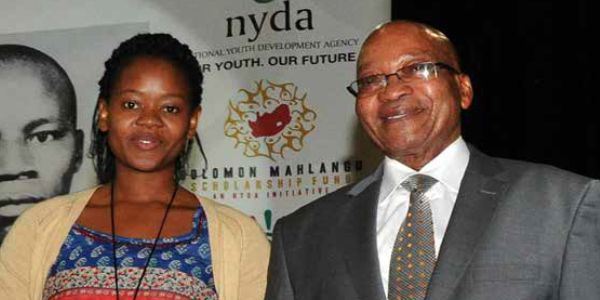 The R20 million fund was recently launched by President Jacob Zuma and shows government’s commitment to investing in the education of the country’s young people. “We want access to quality education to be one of the tangible fruits of freedom for our youth,” said President Zuma.
The R20 million fund was recently launched by President Jacob Zuma and shows government’s commitment to investing in the education of the country’s young people. “We want access to quality education to be one of the tangible fruits of freedom for our youth,” said President Zuma.
The Department of Higher Education and Training and the National Youth Develop-ment Agency (NYDA) each contributed R10 million to the fund.
Learners from disadvantaged areas, who excelled at school and want to further their studies, will benefit from the fund.
It is named after the late struggle icon Solomon Kalushi Mahlangu, who was executed under apartheid laws at the age of 23, after he was wrongfully accused of murder and terrorism.
As the country celebrates 20 Years of Freedom, President Zuma said government was committed to ensuring that young South Africans live a better life than those who lived during the era of apartheid, when education was used as an instrument of defeat.
President Zuma said the fund was in line with government’s national focus on education. “The democratic government views education as an instrument of freedom and development.”
The NYDA also recognises the importance of educating South Africa’s youth and is confident that the fund will grow and reach more young people.
“We envision growing this scholarship into a multi-billion fund, opening the doors of learning to our youth,” said NYDA chairperson Yershen Pillay.
He also called on the private and public sector to get on board to make more young people’s dreams a reality.
Second chance
President Zuma also highlighted another NYDA project - the National Senior Certificate Rewrite Programme - which is helping the country’s youth better themselves.
The programme helps those who failed matric or did poorly, to rewrite the matric exams.
To date, the programme has given more than 8 000 young people a second chance. President Zuma pointed out that some of the graduates of the programme are now beneficiaries of the Solomon Mahlangu Scholarship Fund.
One of these is Ntsako Shiringani, 24, from Mpumalanga, who said the fund and the programme had given her the opportunity to start over.
After matriculating in 2007, Shiringani President Jacob Zuma with Ntsako Shiringani, one the recipients of the Solomon Mahlangu Scholarship Fund. The President recently launched the R20 million fund that helps students from disadvantaged areas further their studies. studied information technology (IT). However, after three years, she decided to go back to matric and better her results.
“I did not pass well in 2007, which is why I ended up going to college to pursue something that I had no interest in. I realised I wasn’t happy and IT was not what I wanted to do as a career so I made the biggest decision of my life. I went back to high school.”
Shiringani once again put on her school uniform and braved sitting in a classroom with learners much younger than her. At first she chose not to do mathematics but after realising that it was a requirement at all the universities she had applied to, she took on the subject.
Shiringani passed all her subjects, achieving five distinctions and 62 per cent for mathematics.
“I’m now older and more focused. I decided to fix my own mess and it is slowly paying off.”
She is now a first-year commerce student at the University of Johannesburg and is the first in her family to attend university. For Isaac Mashego of Sebokeng, the possibility of going to university was always just a dream.
“My mother is unemployed and my father works as a driver for a mining company,” said the 19-year-old, who has eight siblings. “I knew there was no way my parents could afford the fees, so the only way I was going to study was if I got a bursary or scholarship.”
Mashego worked hard in matric and applied for as many bursaries as possible. Even though his results were good, he knew that he did not have a backup plan if he didn’t get a bursary.
Thanks to the Solomon Mahlangu Scholarship Fund, Mashego didn’t need a back up plan and is currently a first year electrical and electronic engineering student at the University of Johannesburg.
“I am so happy that I finally have the power to change not only my future but my family’s as well,” he said.
The fund covers all the costs of the beneficiaries’ studies including tuition, books, meals and accommodation. It is awarded to students studying information and communication technology, law, tourism, geology, logistics, pharmacy, journalism, agriculture, engineering, development studies and supply chain management.
Penalties for late birth registrations
Penalties for late birth registrations sadminThe Department of Home Affairs is calling on parents to register their children’s birth on time to avoid paying a penalty fee for late registration.
ome Affairs Deputy Minister Fatima Chohan urged parents to register their children within 30 days of their birth.
Parents who fail to register their children within this period but do so within the first year of birth will have to pay R70 for late registration.
The penalty forms part of the department’s Regulations on the Registration of Births and Deaths that were published in February. The regulations came into effect on 1 March.
Registering children is important for South Africa’s National Population Register. The department has a presence in over 300 hospitals across the country to make it easier for parents to register their children.
“It’s important for the National Population Register at all times to be fairly accurate and reliable, hence the importance of requiring people to register - whether its births, marriages or deaths,” explained Deputy Minister Chohan.
“Every child, in terms of the Constitution, is deserving of citizenship and identity. We found that there is a shift to register children within the first year,” she said.
Updating and strengthening legislation on birth registration was an important step in protecting citizenship, identity and human rights, the Deputy Minister added.
She also called on those who applied for smart card IDs to collect them if they received SMSes saying they were ready, adding that is was possible to receive a smart card ID two days after applying for one.
De Hoop Dam gives hope to thousands
De Hoop Dam gives hope to thousands sadminWalking long distances through thorny bushes to access clean water will soon be a thing of the past for residents of Sekhukhune District, thanks to the opening of the De Hoop Dam.
 President Jacob Zuma recently opened the much-awaited De Hoop Dam, which will help address water problems in Limpopo.
President Jacob Zuma recently opened the much-awaited De Hoop Dam, which will help address water problems in Limpopo.
This fulfils the commitment made by the President in 2009, during his State of the Nation Address, when he said: “As long as there are communities without clean water or proper sanitation, we shall not rest”. In 2003, it was announced that a dam would be constructed in the Olifants River system to unlock the rich mineral deposits in Limpopo.
The sod-turning ceremony followed in 2007 and construction began, leading to the completion and opening of the project. The dam, costing more than R 3 billion, was built by the Department of Water Affairs to supply potable water to thousands of people in the Sekhukhune District.
De Hoop Dam, which is the 13th largest in the country, created more than 1 000 jobs. It is one of the key projects that fall under the umbrella of the Presidential Infrastructure Coordination Commission, which was established in 2012 to coordinate and fast-track infrastructure projects, under the leadership of President Zuma.
The dam will supply water to the towns, industries and poorly serviced rural communities in the Sekhukhune, Waterberg, and Capricorn Districts of Limpopo.
It will also supply water to the mines to help unlock vast mineral deposits, mainly in the form of platinum group metals found in the region. It will help spark both social and economic development for this region.
Progress
President Zuma said the dam confirmed the good story of the country - the story of development and progress that South Africa has achieved since 1994.
“The opening of this dam is yet another contribution to that drive of building a better South Africa through improving access to basic services and socio-economic infrastructure,” he said.
Millions of South Africans now have access to water, which they did not enjoy before 1994.
Access to a basic level of water increased from just over 60 per cent of households in 1994/95 to over 95 per cent of households in 2011/12.
“When we talk about this area being water stressed, we are talking about the plight of many people such as the unacceptable conditions of the people of GaMashabela near Jane Furse who struggle to access clean drinking water
“People still have to walk through thick and thorny bushes to reach the wells of Ntsoaneng GaKgari Mountains in order to access fresh water. Some of the residents still rely on borehole water which is insufficient to meet the demand of these communities,” the President said.
He also told the community that the pipeline from Jane Furse to Lobethal, which covers the villages of Ga-Mashabela, Diphagane, Ga-Phahla, Ga-Marishane, Tisane and Mamone, was 70 per cent complete, while a pipeline from Mooihoek to Tubatse was 100 per cent complete.
“The pipeline will provide water to the villages including Mandagshoek, Mashabela, Ntsoaneng, Driekop and River Cross. The bulk distribution system connected to the dam will ensure that over a period of time, all the people of this area will be served with an uninterrupted water supply, which is the ultimate goal of government.”
Water and Environmental Affairs Minister Edna Molewa said that government had launched a number of infrastructure projects throughout the country.
“It’s a good story. A project like this is for all of us to continue to work hard and support the President in his endeavour to fight poverty in this country,” said Minister Molewa.
Limpopo Premier Stanley Mathabatha said that through the opening of the dam, government had improved the lives of people in the province.
“Today is better than yesterday, we are certain that tomorrow, will be better than today,” he said.
Slovoville residents get new clinic
Slovoville residents get new clinic sadminA new R16 million clinic has opened in Slovoville, near Dobsonville in Soweto, offering a range of health services to residents at their doorstep.
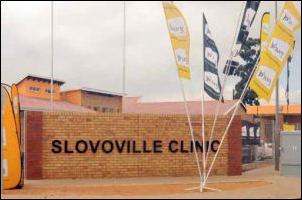 Speaking at the unveiling of the clinic, City of Johannesburg Mayor Parks Tau said the clinic offered a variety of services that would give the community access primary health care.
Speaking at the unveiling of the clinic, City of Johannesburg Mayor Parks Tau said the clinic offered a variety of services that would give the community access primary health care.
The facility also meets the standards that would make it possible for the National Health Insurance (NHI) to be rolled out. “It is important today that we should acknowledge and congratulate the Department of Health within the city... for initiating and implementing a project that will make us proud.
“The clinic is also a facility to meet the standard of NHI. While the scheme is being rolled out in other areas, we believe we should be able to build a clinic that meets those standards that will make it possible for NHI to be rolled out in the area,” he said.
The NHI is a financing system that will provide all South Africans with essential health care, regardless of their employment status. NHI compliant health facilities have to meet strict standards relating to cleanliness, safety and security of patients.
The Slovoville Clinic offers a range of services covering reproductive health, maternal (antenatal and postnatal) health, women’s health, youth and child health (including immunisation), HIV and AIDS, sexually transmitted infections, tuberculosis, management of acute illness, management of chronic conditions, health promotion and emergencies.
The clinic has five consultation wards for chronic diseases, Mayor Tau said, adding that the city had entered into partnerships with doctors from private clinics for them to work with the clinic.
“We have agreed that Slovoville will be a pilot area for us to do a health profile of the community.
“We will be visiting homes and people will be visiting the clinic. We will then come back in a year and we will measure how the health profile of the community has improved,” the Mayor said.
First Lady Bongi Ngema-Zuma, who in The newly built clinic in Slovoville means residents no longer have to travel to neighbouring communities to get quality health care. 2010 started a foundation that promotes health, also attended the opening of the clinic.
“I stand here representing the Bongi Ngema Foundation. I grew up in a family that is affected by diabetes. My mother lived with diabetes for three decades. During her time, there were no clinics like this one that cares and treats diabetic patients.
“I commend you [Mayor Tau] for the wonderful work done, and indeed this is a good story to tell and I am going home to tell everyone,” she said.
Ngema-Zuma, who visited the area while the clinic served the community from a mobile container, also praised the nurses for their dedication, despite working in an under-resourced situation.
The construction of the new brick and mortar clinic, which is among the first to be built with a back-up generator, started in 2013.
It has 18 consultation rooms, an emergency room, drug storeroom, linen room, counselling room and waiting area with an open reception.
The Slovoville Clinic, Mayor Tau said, will go a long way in providing comprehensive reproductive and antenatal services to patients.
The clinic will serve a population of 8 000 in a remote area that consists of RDP houses, a mining complex and mining hostel.
The area is situated in the south of Soweto, and was named after Joe Slovo – a struggle stalwart who went on to become the first Minister of Housing of the new democratic South Africa
SA’s water supply on the increase
SA’s water supply on the increase sadminThe Lesotho Highlands Water Project is providing much-needed water to South Africa and developing infrastructure and generating energy in Lesotho.
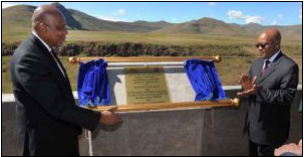 This is a win-win situation for both countries, says President Jacob Zuma. Speaking at the sod-turning ceremony for phase two of the project in Maseru, Lesotho, President Zuma said the project had massive benefits for both countries.
This is a win-win situation for both countries, says President Jacob Zuma. Speaking at the sod-turning ceremony for phase two of the project in Maseru, Lesotho, President Zuma said the project had massive benefits for both countries.
In operation for over 20 years, the Lesotho Highlands Water Project supplies South Africa with about 780 million cubic metres of water a year.
When fully operational, phase two of the project will significantly increase the volume of water supplied to South Africa. Phase one of the project, which was funded by the World Bank, was completed in 2004.
The project has provided Lesotho with a number of benefits, the President noted. “There has been benefits of infrastructure development during phase one which include 102km of paved roads, 265km of gravel roads, 1 133km of roads rehabilitated to grade 1 standard, 11 bridges built including three bridges between Lesotho and South Africa in Maseru, Maputsoe and Caledonspoort,” President Zuma said.
The benefits also include 299km of power lines, staff housing for about 300 workers as well as hydro-electricity generation es- Lesotho’s King Letsie III and President Jacob Zuma launch phase two of the Lesotho Highlands Water Project in Maseru, Lesotho. timated at 72 megawatts.
The building of the Metolong Dam, to which South Africa contributed R50 million, also meets the water needs of the Kingdom of Lesotho, the President said, adding that Lesotho had also gained a village and an Information Centre at Metolong.
President Zuma said the benefits to South Africa were also huge.
“The country gains high quality water transfers and job opportunities. There is improved infrastructure in Clarens, Fouriesburg, Ficksburg and Ladybrand in the form of new border crossings and improved amenities, community halls, clinics, houses and improved rail facilities such as in Ficksburg,” he said.
The purpose of the project is to provide Lesotho with a source of income in exchange for providing water to the central Gauteng province, where most industrial and mining activity occurs in South Africa, as well as to generate power for Lesotho. South African companies have a significant presence in Lesotho and are involved in sectors such as housing, food and beverages, construction, retail, hotels and leisure, banking and medical services.
Meanwhile, closer to home, Water and Environmental Affairs Deputy Minister Rejoice Mabudafhasi officially handed over the R163 million Christiana/ Hertzogville Phase One Bulk Water Infrastructure project in Hertzogville in the Free State.
About 10 000 community members are expected to benefit from the project. Residents will no longer have to walk long distances to fetch water.
Water is being extracted from the Vaal River near Christiana in the North West with a pipeline running 45km between Christiana and Hertzogville.
It flows to a nearby pump station and then into a dam, where it is purified. The Deputy Minister said the department was working with the Department of Cooperative Governance and Traditional Affairs, the Lejweleputswa District and Tokologo Local Municipalities to ensure completion of phase two of the project.
“Phase two is aimed at eradicating water backlogs for Tokologo Local Municipality communities. It will provide water services to over 9 409 people within the service area,” said Deputy Minister Mabudafhasi.
The Lesotho Highlands Water Project and Christiana/Hertzogville Water Infrastructure project highlight government’s efforts to provide water to South Africans.
According to the Twenty Year Review released by the Presidency, the country has met its Millennium Development Goal (MDG) – to halve the proportion of the population without sustainable drinking water – in 2008, ahead of the 2015 deadline.
Access to a basic level of water increased from just over 60 per cent of households in 1994/95 to over 95 per cent of households in 2011/12
Show your support for Child Protection Week
Show your support for Child Protection Week sadminNational Child Protection Week is celebrated annually in South Africa from 26 May to 1 June, to raise awareness about the rights of children
The campaign, launched in 1997, highlights the protection and care of children as a national priority.
This year the campaign, led by Social Development Minister Bathabile Dlamini, calls on all South Africans to protect children and create a safe and secure environment for them.
This year’s theme is ‘Working Together to Protect Children’.
The Department of Social Development is urging South Africans across the country wear green ribbons, which symbolises life, growth, hope, care and support for children, during Child Protection Week.
According to the department, more than 100 cases of child abuse are reported every week and nearly 50 000 cases of crimes against children, under the age of 18, were reported between 2011 and 2012.
To improve the safety of children, gov- SAnews ernment departments have joined forces. The South African Police Service (SAPS) last year rolled out a victim empowerment learning programme as part of its in-service training programme. The programme teaches police officers how to help victims and improve investigations of sexual offences.
Family Violence, Child Protection and Sexual Offences Units (FCS) have also been re-introduced at all 176 SAPS clusters in the nine provinces. There are currently 2 155 detectives at these units with 1 276 vehicles. To date, FCS units have secured over 363 life sentences, with a conviction rate of 73 per cent for crimes against women above 18 years old and 70 per cent for crimes against children under 18 years old.
SAPS, in a partnership with the Department of Basic Education, also introduced preventative programmes in schools across the country. As part of these programmes, learners are encouraged to report any form of abuse to their school, teachers or the police.
Thanks to various initiatives under the campaign, the number of children who were neglected or ill-treated dropped from 5 568 in 2004, to 2 949 by the end of 2012, according to the department
School registration for 2015 kicks off
School registration for 2015 kicks off sadminPublic schools across Gauteng have opened their doors for the registration of learners for the 2015 academic year.
Gauteng Education MEC Barbara Creecy launched the Public School Admissions Campaign recently, which included the distribution of pamphlets encouraging parents to apply now to avoid the last minute rush in 2015.
“There is high demand for space in Gauteng schools. We have over 2 000 public ordinary schools that accommodate 1.9 million learners. Apply early so that we can accommodate you.
“For us, it means we will be able to plan for the number of children who are coming into our system. For parents, it means they will be able to get a school that is closer to their place of work or residence,” MEC Creecy said.
The department processed over 20 000 late applications for the 2014 academic year, an increase from 15 000 in the previous year.
Applying late reduces the chances of parents getting the school of their first choice where they meet the criteria. This also means that learners will be placed at a school where there is space available and this might not be close to where their parents work or reside.
Parents, who wish to register their children for admission to a public school in Gauteng, can go to their nearest school to pick up application forms for learners who want to start Grade 1 or Grade 8 in 2015.
Application forms should be returned to the school by 27 May 2014.
“We once again urge parents to work with us to ensure all our schools are ready to operate from the first day of school in 2015.
Parents who will be applying need to take a completed application form with the following documentation:
- Birth certificate or certified copy (a baptismal certificate is not acceptable).
- At least one parent’s ID.
- Immunisation card (Grade 1).
- Study permits for legal immigrants.
- Asylum documents for refugees and asylum seekers.
- The latest school report card.
SA steps up fight against cancer
SA steps up fight against cancer sadminFifty-four pupils from Gonyane Primary School in Bloemfontein were among the first group of girl learners in the country to be vaccinated against the Human Papilloma Virus (HPV).
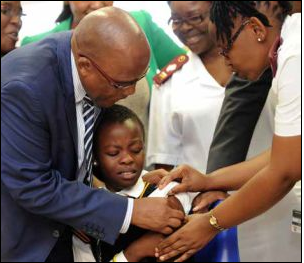 he Grade 4 learners, aged between nine and 10 years, are beneficiaries of the country’s HPV vaccination campaign.
he Grade 4 learners, aged between nine and 10 years, are beneficiaries of the country’s HPV vaccination campaign.
Health Minister Aaron Motsoaledi, along with his Deputy Gwen Ramokgopa, launched the vaccination programme at the Free State school recently.
“About 130 countries across the globe are vaccinating young girls for HPV. So far, about 170 million children have been vaccinated worldwide and I am proud to say the number has increased by 54 today,” said the Minister. The Minister, who lost his mother to cervical cancer, said negotiating for the HPV vaccine to be accessed freely by South Africans had not been a walk in the park.
“Breast cancer is a leading deadly cancer in women, followed by cervical cancer… but we do not have a vaccine for it. Since we have a vaccine for HPV, let us help one another to fight cervical cancer,” said Minister Motsoaledi. Three thousand health workers have been trained to work in the HPV vaccine programme across the country.
The Minister explained that girls would take a second dose of the vaccine after six months and would then be vaccinated once every year. Minister Motsoaledi said that at some point, Free State recorded the highest maternal mortality rate compared to other provinces but those figures have declined.
“Free State was chosen to launch this programme with the aim of lowering maternal mortality, even more so because most women aged between 35 and 55 years die of cancer,” he said.
About 16 million women over the age of 15 are at risk of cervical cancer in South Africa. The Department of Health aims to reduce cervical cancer related deaths gradually within the next two to three decades through the vaccine programme.
Speaking at the launch, breast cancer survivor Asante Shongwe shared her ordeal and how she dealt with the disease.
“I grew up like any other child from a humble background. Unlike the others, I was raised by a single mother. I paid the necessary attention to my school work and that helped me understand my situation and cope with cancer better than I could possibly have,” said Shongwe.
She stressed how important it was to educate learners about cancer.
“I stand before you without two breasts but I am healthy, my mind is in a good state... Lack of knowledge and ignorance is what kills most women,” Shongwe said.
First Lady Thobeka Mabhija-Zuma expressed her support for the HPV vaccine programme at the launch, saying she would do all she could to ensure the success of the programme.
“Today South Africa is investing in the future of our young girls,” said Mabhija-Zuma, who is the founder of the Thobeka Mabhija-Zuma Foundation.
*More Matshediso works for GCIS in the Free State
A shot at a cervical cancer-free life
A shot at a cervical cancer-free life sadminEven though the little girl’s hands were trembling at the thought of the injection, little Nolubabalo Palesa Qhautse put on a brave face when it was her turn to get vaccinated against the Human Papilloma Virus (HPV).
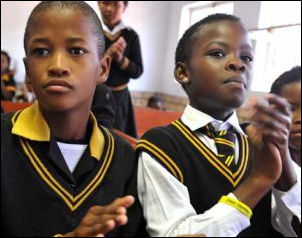 but her mother, Dimakatso Qhautse, stood vigil as Health Minister Dr Aaron Motsoaledi administered the HPV vaccine.
but her mother, Dimakatso Qhautse, stood vigil as Health Minister Dr Aaron Motsoaledi administered the HPV vaccine.
Nolubabalo, 9, was among the Grade 4 learners from the Gonyane Primary School in Mangaung, who received their first dose of the HPV vaccine from the Minister.
Nolubabalo knew that the vaccine would protect her against cervical cancer; her mother had told her so.
“She didn’t tell me in detail what cervical cancer is, but she promised the vaccine is going to protect me. The injection was and is still painful. I almost cried but I held myself back because there were so many people watching,” she said.
Qhautse, who was at the school to witness the launch of the HPV vaccine campaign, said she was relieved that her daughter would be protected from the virus, which almost killed her mother.
“My mother had cervical cancer and her womb had to be removed. Fortunately, she survived. When I heard about the campaign launch, I didn’t hesitate and signed the consent form from the school immediately. Thanks to government, our children will not experience what most women go through due to the virus,” said Qhautse.
Women’s health
South Africa took a major step in the safeguarding of women’s health when Minister Motsoaledi rolled out the first HPV vaccine campaign, which will protect young girls from getting cervical cancer caused by the HP-virus.
Minister Motsoaledi announced the national vaccination campaign in 2013 during his Budget Speech. An estimated 500 000 girls in 17 000 schools will be vaccinated.
During the launch, a proud Minister Motsoaledi said the country was making history and the day marked the beginning of the effective prevention of cervical cancer. He said although the vaccine is a bit pricey - each dose costs between R700 and R1 000 in the private sector - he was determined to get the vaccine for the people.
“Today, South Africa is one of the few countries on the continent to provide this vaccine to all Grade 4 learners. On this continent, we are the first to vaccinate as many as half a million girls. The one country which provides this vaccine is Zambia and it only gives 25 000 vaccines. It’s a serious disease affecting women in the world,” the Minister said.
Grade 4 learners from the Gonyane Primary School in Mangaung celebrate during the launch of the HPV vaccination campaign at their school.
Saving lives
He also noted that 6 000 women get cervical cancer every year. About 80 per cent are African women. Between 3 000 and 3 500 will die annually, even after treatment.
“Half of them are between ages 35 and 55 years,” he said, urging women to get screened for cervical cancer.
The Minister also thanked parents for agreeing to vaccinate their children and assured them that health policies were based on best evidence, including the department’s own experts’ committee, which advises the department.
He said that although girls from the higher grades have missed out on the vaccination, the department would make sure that every learner from Grade R gets the vaccine when they reach Grade 4 to reduce the incidence of cervical cancer in the near future.
Treasury has allocated R400 million for the campaign.
Executive Director at Wits Reproductive Health and HIV Institute, Professor Helen Rees, said the vaccination of girls at a young age would lower infection rates and would also reduce infection in boys.
“... If we can get the coverage in young girls up high enough, there’s a benefit for young boys because as you decrease the infection [in girls], there will be less infection in boys,” said Rees.
Free State Basic Education MEC Tate Makgoe said he was pleased that the programme was launched in his province. He also thanked President Zuma for making health and education a priority. “We support the programme because a world without health is useless.”
Before the launch, the school governing body was contacted and parents were given consent forms to sign for their children to be vaccinated.
Strengthening local govt to improve lives
Strengthening local govt to improve lives sadminLocal government
The Department of Cooperative Governance and Traditional Affairs has established an internal nerve centre to come up with plans to detect and deal with violent service delivery protests.
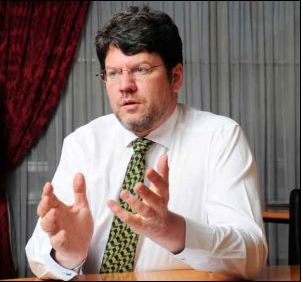 In recent months the country has seen a wave of violent service delivery protests, which has resulted in state property being destroyed.
In recent months the country has seen a wave of violent service delivery protests, which has resulted in state property being destroyed.
The community of Bekkersdal in Westonaria is one among those who took to the streets, burning tyres and blocking roads, as they demanded better services.
Cooperative Governance and Traditional Affairs Deputy Minister Andries Nel said the violence that often accompanies protests is a concern for government.
“Let’s look at the first two months of 2014. A breakdown of the protests demands during the first two months of 2014 shows that water, housing, electricity and sanitation were the major reasons for unhappiness.
“Fifty-four per cent of the protests were in the metropolitan areas. Of concern is that 92 per cent of the protests during 2014 so far were violent,” said Deputy Minister Nel. He said dedicated staff had already been allocated to the nerve centre, which will have a rapid response and structural reform component as well as an intelligence unit.
Rapid response will be responsible for emergency short-term interventions and will help municipalities address communities’ concerns through immediate political interventions.
Structural reform will help provide municipalities with administrative, managerial and engineering skills, among others. The intelligence unit will give analytic and communications support to the centre.
Service delivery protests
The Deputy Minister added that the department was working closely with the South African Police Service (SAPS) and municipalities to detect early warning signs of service delivery protests.
According to Deputy Minister Nel, local government is an important aspect of the state as it interacts closely with communities.
“This is probably one of, if not the most, important spheres of government because it is closest to the people and has the most direct impact on the quality of life of people in so far as it relates to the provision of basic services and the creation of an environment within which people live.”
Services such as water, electricity, maintenance of local roads and municipal infrastructure are the responsibility of local government. Since 1994, national government has allocated substantial funds to build municipal capacity, he pointed out.
The Siyenza Manje Programme, which helps low capacity municipalities address service delivery challenges through hands-on support and skills transfer, spent about R933 million from 2006/07 to 2009/10. Almost R5.8 billion has been allocated for municipal capacity support from 2013/14 to 2016/17.
Although progress has been made in transforming the local government and delivering services to communities, challenge still exist. Some of these include the shortage of technical skills, poor recruitment practices and violent service delivery protests.
Communication
Deputy Minister Nel noted that in some cases, the lack of response to communities’ concerns by local authorities often led to protests. “The failure of the authorities to respond positively to community demands often leads to protests. Corruption is mentioned by all the protests participants as a major concern in the operation of local government and recently, lack of employment is raised at protests.”
According to the Deputy Minister, local government authorities need to improve the way they communicate with communities. “Poor communication between municipalities and communities has been identified by both analysts and government as one of the challenges surrounding protests.
“An increase in service delivery protests illustrates a need to strengthen the innovative platforms of participatory democracy and to foster closer and more regular engagement between citizens and their public representatives,” he said.
He added that skills and capacity were also areas that needed local government’s urgent attention.
“The building of capacity and skills and the appointment of suitably qualified and competent people has been identified as an important building block in ensuring an improvement in service delivery at local level.”
New regulations
With regards to skills, the department has made progress in efforts to professionalise local government. The department has introduced “Regulations on the Appointment
and Conditions of Employment of Senior Managers”.
The department says the regulations are aimed at strengthening governance and guiding municipalities in the appointment of senior managers to ensure that their skills are specific for the purpose.
The regulations will also provide for the creation of a database of managers who have been dismissed for misconduct or corrupt activities to prevent them from being rehired by other municipalities once they are fired. Through the new law, senior managers will also have to declare their financial interests regularly.
With qualified managers and improved communication between local authorities and communities, Deputy Minister Nel is confident that local government is on the right track to deliver services to communities
Bekkersdal Ubuntu restores damaged clinic
Bekkersdal Ubuntu restores damaged clinic sadminLocal government
The people of Bekkersdal in Gauteng is making amends for their vandalism during service delivery protests, which saw them damaging community facilities.
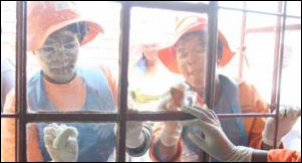 Early this year, the informal settlement was in flames as angry residents burnt tyres and destroyed state property.
Early this year, the informal settlement was in flames as angry residents burnt tyres and destroyed state property.
Residents have now taken it upon themselves to renovate the clinic that was burned during the protests.
The man behind efforts to clean up and renovate the clinic is Bekkersdal resident Sello Rampeku.
One morning while listening to a radio programme, he heard the presenter talk about how young people had destroyed property during the service delivery protests.
“What he was saying really concerned me because most of our of elderly people rely on the clinic for their medication. Some of them take chronic medication,” he says.
Rampeku didn’t waste time. He set up a meeting with the clinic head, Violet Pooe, to present the idea of the community uniting to clean up and repair the clinic.
“I met with the clinic head to assess the damage and found out that one of the things that was stolen was the electricity cables. I spoke to Eskom to help with the cables and restore power and the Department of Health helped us with medication.”
Rampeku then asked for help from local organisations and the support he received was overwhelming.
“I was surprised because more than 100 people turned up for the cleaning campaign,” he says.
Members of organisations such as the Kamohelong Home Based Care, Zivuseni Project and Greater Westonaria Association of Youth Clubs (GWAYC) also assisted with the project. Keitumetse Sedumedi, of GWAYC, said the club got involved because they were dedicated to serving the community.
“By helping we are making sure that the community receives their daily basic services from the government,” she said.
Thabang Super Market donated cleaning equipment for the project and Colonel Baba Mputwane of the Bekkersdal Police Station sponsored the window panes.
The Gauteng MEC for Cooperative Governance, Traditional Affairs and Human Settlements, Ntombi Mekgwe, applauded the community for fixing the clinic.
“People should not see government as a cash cow but (as a) part of them. Also, it cannot be right for people to wait for government when they can provide a solution to their problem.
“The residents who participated in the fixing of the clinic have shown true leadership, patriotism and Ubuntu,” MEC Mekgwe said.
NHI improves health care in KZN
NHI improves health care in KZN sadminResidents of KwaZulu- Natal are enjoying the benefits of three National Health Insurance (NHI) pilot sites in the province, which have brought a noticeable improvement in health care.
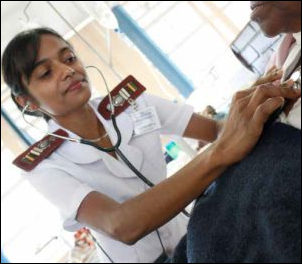 The NHI is a financing system that will make sure all South Africans get essential healthcare, regardless of how much they earn.
The NHI is a financing system that will make sure all South Africans get essential healthcare, regardless of how much they earn.
The roll out of the NHI is expected to take about 14 years.
As part of the first phase, in 2012, 11 pilot districts were identified to test the feasibility of the NHI.
Recently, KwaZulu-Natal Health MEC Sibongiseni Dhlomo gave an update on the progress of NHI at one of the province’s pilot districts, Amajuba, where the R13 million Ingongo Clinic in Newcastle was opened.
MEC Dhlomo said the department had provided mobile pharmacy services so that chronic patients would be able to collect their medication in the district as part of the NHI. “Three doctors are currently providing medical services at five clinics in this district, with another one contracted through a supporting non-governmental organisation partner.
“School health teams were appointed and Dashni Sheik, a nurse at Edendale Hospital in KwaZulu-Natal, is witnessing first hand the benefits on the National Health Insurance. pregnant. They easily die … due to issues like hypertension.”
However, the Minister pointed out that the new device was not only targeted at young girls, but married women, who are advised by their doctors not to fall pregnant again, following previous pregnancy-related complications. Once inserted, the device is effective for three years. “You no longer have to go to the hospital every three months, you’ll now go after three years. But if you want to have a baby before three years, you just come and ask us to remove it,” said Minister Motsoaledi.
Monyeni plans to educate her family about the new contraceptive device. “I have younger sisters and both of them have children, I will also advise them to get the device.”
She added that government had done a good thing by making the contraceptive device freely available but it should also be rolled out to high schools, given the high number of teenage pregnancies.
Sister Rebecca Mokoma, who is a nurse at the Laudium Community Health Centre, said the device was becoming popular with residents of Atteridgeville, Erasmia, Mooiplaas, Olievenhoutbosch and other areas. The clinic services 360 000 people from these areas.
“On an average day we get about 10 people between the ages of 30 and 35 coming for the device. Some say they heard about it from the media or through word of mouth.” She added that before the device is implanted patients are screened for breast cancer and pregnancy.
“We give the device to girls from the age of 14 years upward. The patients who come back for follow up visits say they only have minimal side effects such as nausea and dizziness, which only lasts for two weeks after the implants.”
The clinic has five nurses and one doctor trained to insert the contraceptive device. Countrywide, 2 000 nurses have been trained to administer the device, the Minister said.
New contraceptive device welcomed are currently covering 4 232 Grade 1 learners in 98 schools.”
The MEC added that his department had appointed district clinical specialist teams to cover all primary health care clinics and hospitals in the district.
Another district to which the NHI has brought change is the uMgungundlovu District. Edendale Hospital, near Pietermaritzburg, falls under this district.
Dashni Sheik is a nurse here and is the hospital’s resuscitation coordinator. Her role is to ensure the hospital’s 47 wards all have resuscitation trolleys.
A resuscitation trolley has all the equipment needed to resuscitate or perform cardiopulmonary resuscitation (CPR), an emergency procedure to restore blood circulation and breathing. “Before the NHI was piloted some wards in the hospital, such as physiotherapy did not have a resuscitation trolley. This is all new and part of the NHI,” she said.
Sheik, who has been a nurse for 16 years, added that South Africa is moving in the right direction with health care.
She has seen a number of changes at the hospital, since it became part of the NHI pilot programme.
The hospital is cleaner, security is tighter, while queues and waiting times are shorter after the hospital hired queue marshals. Pensioner Thandi Mkhize from KwaDambuza, a patient awaiting surgery, agrees with Sheik.
“I have lived in this area all my life. I have seen Edendale Hospital at its lowest with long queues and low levels of cleanliness. There has been huge change. I didn’t have to wait long to be admitted. The queues move faster and medicine is always available,” said Mkhize. Initially the Department of Health selected 10 NHI pilot sites, with KwaZulu-Natal allocated two in uMgungundlovu and uMzinyathi. The provincial department then added a third site, Amajuba, and is carrying the cost of this site. These efforts have seen the facilities at the hospital improve, with the opening of the Communicable Disease Clinic (CDC), which cost over R41 million.
The new clinic has an ARV pharmacy, consultation rooms, counselling rooms, coughing booth and a special waiting area for clients.
The CDC provides management in HIV, TB and sexually transmitted infections, as well as cervical cancer screening, health screening, pharmacy services, social work services and diet services.
Sheik explained that the hospital also revamped its emergency department and opened a psychiatric department, which needed to be at the same as level as that of private hospitals.
The hospital also has more equipment and staff.
According to the Twenty Year Review released by Presidency, since 1994, 1 500 health facilities were built.
The review adds that implementing the NHI would reduce the costs of private health care, improve the quality of health infrastructure and services, as well as strengthen and expand primary health care services.
New contraceptive device welcomed
New contraceptive device welcomed sadminDipuo Moyeni, a mother of two, had her first child when she was just 15 years old.
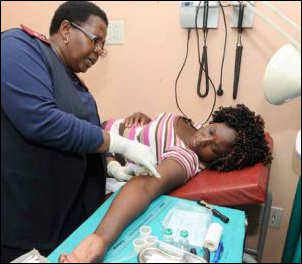 and while the 26-year-old loves her two children, she wishes that the new sub-dermal contraceptive device, which was recently launched by Health Minister Aaron Motsoaledi and is available to women free at government clinics, was available when she was younger.
and while the 26-year-old loves her two children, she wishes that the new sub-dermal contraceptive device, which was recently launched by Health Minister Aaron Motsoaledi and is available to women free at government clinics, was available when she was younger.
“I was only 15 when I had my first child. I was a child myself and did not know anything about raising children. If the device was available back then maybe my situation would have been different,” she said. Moyeni recently had the contraceptive device implanted in her arm during a visit to the Laudium Community Health Centre in Gauteng.
Even though she was a little scared of the procedure, Moyeni said she was glad she went through with it because the new device prevents pregnancy and has fewer side effects than the injection, the type of contraception she previously used.
At the launch, Minister Motsoaledi explained that the contraceptive device is expected to decrease the number of unwanted teenage pregnancies and reduce the number of maternal deaths in the country.
It is implanted below the skin of the arm and will be added to the current birth control methods used by women to prevent unwanted pregnancy.
The Minister said there were one million women falling pregnant in South Africa a year, eight per cent of whom were below the age of 18. He said these minors were giving birth to 80 000 unplanned babies annually.
“They contribute to 36 per cent of all maternal deaths, because they are too young to fall pregnant. They easily die … due to issues like hypertension.”
However, the Minister pointed out that the new device was not only targeted at young girls, but married women, who are advised by their doctors not to fall pregnant again, following previous pregnancy-related complications.
Once inserted, the device is effective for three years. “You no longer have to go to the hospital every three months, you’ll now go after three years. But if you want to have a baby before three years, you just come and ask us to remove it,” said Minister Motsoaledi.
Monyeni plans to educate her family about the new contraceptive device. “I have younger sisters and both of them have children, I will also advise them to get the device.”
She added that government had done a good thing by making the contraceptive device freely available but it should also be rolled out to high schools, given the high number of teenage pregnancies.
Sister Rebecca Mokoma, who is a nurse at the Laudium Community Health Centre, said the device was becoming popular with residents of Atteridgeville, Erasmia, Mooiplaas, Olievenhoutbosch and other areas. The clinic services 360 000 people from these areas.
“On an average day we get about 10 people between the ages of 30 and 35 coming for the device. Some say they heard about it from the media or through word of mouth.” She added that before the device is implanted patients are screened for breast cancer and pregnancy.
“We give the device to girls from the age of 14 years upward. The patients who come back for follow up visits say they only have minimal side effects such as nausea and dizziness, which only lasts for two weeks after the implants.”
The clinic has five nurses and one doctor trained to insert the contraceptive device. Countrywide, 2 000 nurses have been trained to administer the device, the Minister said.
Lengthy strikes bad for the economy
Lengthy strikes bad for the economy sadminLabour issues
Strikes that continue for a long time have a negative impact on the economy and do not benefit anyone
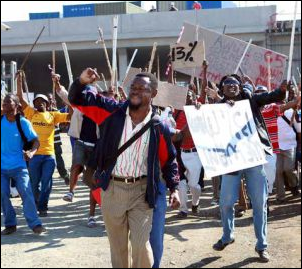 This is according to the Department of Labour, which added that wages lost because of strikes went up from R6.6 billion in 2012 to R6.7 billion in 2013. “There are no winners in prolonged strikes. They hurt both employers and employees the same - employers lose income while trade unions or employees lose wages, which is hard to recover after a prolonged industrial action.
This is according to the Department of Labour, which added that wages lost because of strikes went up from R6.6 billion in 2012 to R6.7 billion in 2013. “There are no winners in prolonged strikes. They hurt both employers and employees the same - employers lose income while trade unions or employees lose wages, which is hard to recover after a prolonged industrial action.
“Strikes also have a negative impact on government’s efforts to create jobs,” the Department of Labour said.
In the past few years, the country has been gripped by a wave of strikes resulting in the destruction of property, loss of income and lives.
In an effort to prevent strikes and deal with the violence accompanying them, the department will discuss the introduction of a system of compulsory negotiations with its social partners at the National Economic Development and Labour Council (NEDLAC).
The department is also worried about the behaviour of some parties during strikes.
“We have seen parties acting outside the legal framework provided for by legislation, which is an area of concern. However, we are aware that there are measures in place to deal with this phenomenon.”
The department is also planning a Labour Relations Indaba where various issues relating to strikes will be discussed by government, business and labour.
“The intention of the indaba is to address the issues of violent strikes, the duration of industrial action, minimum wages as well as consider introducing interest arbitration as a way of limiting or dealing with long duration of industrial actions,” the Department of Labour said.
Difference in income, race and gender are some of the major causes of strikes.
“Inequality in earnings is compounded by a lack of income security, particularly for workers when they reach retirement and for those outside of secure, permanent or regular temporary employment.
“The lack of income security places pressure on workers to maximise earnings when they are in paid employment … and makes compromise difficult,” it added.
With the discussions at NEDLAC and a labour indaba planned, the department is confident that such interventions will produce results.
Workers’ Day commemorated
Workers’ Day commemorated Estelle GreeffLabour issues
As South Africa celebrates 20 Years of Freedom, workers across the country also celebrated Workers’ Day, known as May Day. The celebrations were held on 1 May, which was a public holiday.
Workers’ Day has been officially observed in South Africa since 1994.
Government is committed to ensuring the welfare of workers.
Over the years, government has put in place various laws and regulations that prevent discrimination and victimisation in the workplace.
Collective bargaining paves way for agreement
Collective bargaining paves way for agreement sadminLabour issues
During strikes you might have heard the term "collective bargaining" used by labour experts and analysts.
To those who are not familiar with the language used during strikes this term might be confusing.
Vuk’uzenzele spoke to the Department of Labour to find out what collective bargaining is and why it is important during wage negotiations.
Collective bargaining
Collective bargaining is a process where the employer, employee and the mediator sit around the table to discuss wages and conditions of employment.
For example, during public service wage negotiations the employer would be the Department of Public Service and Administration representing government and trade unions representing employees while the mediator would be represented by General Public Service Sector Bargaining Council.
According to the Department of Labour, collective bargaining is also a vehicle through which employees and employers negotiate for improved working conditions through partnerships.
“It facilitates the relationship between employers and trade unions as well as gives them the opportunity to talk about their problems, challenges and how to resolve them and deal with workplace conflict,” says the Department of Labour.
Agreements
One of the advantages of collective bargaining is the settlement of differences through discussions and agreements rather than conflict and confrontation. It is different from arbitration where the solution is based on a decision of a third party.
Collective bargaining is also a form of participation. Both parties participate in deciding what proportion of the ‘cake’ is to be shared by the parties entitled to a share.
Labour relations
Collective bargaining is an important aspect in the concept of social partnership in labour relations. It could be described as a partnership between the employer and labour designed to maintain non-confrontation in settling disputes, which may arise between employers and labour.
It also builds trust and understanding between employer and employee and an attitude of attacking problems together rather than each other and improving industrial relations.
It also establishes a productive relationship between the union and the employers’ organisation where the latter is involved in the negotiation process
Govt tackles child labour
Govt tackles child labour sadminLabour issues
Government has warned that it will take strong action against those who make use of child labour.
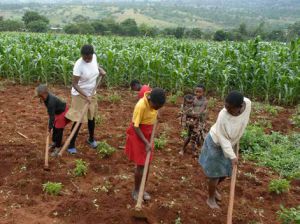 According to the Department of Labour, child labour is when children work before they reach the age of 15 or complete Grade 9.
According to the Department of Labour, child labour is when children work before they reach the age of 15 or complete Grade 9.
The Basic Conditions of Employment Act prohibits the employment of children below the age of 15 years, while the South African Schools Act prohibits children from becoming involved in economic work before they reach the age of 15 or complete Grade 9, whichever happens first.
The department has warned that those who do not respect these laws will face harsh penalties. “It is a criminal offence to employ a child and the offence carries a maximum of six years of imprisonment in terms of the Basic Conditions of Employment Amendment Act, 2013,” said the department.
In most cases child labour involves work that is exploitative, inappropriate for the child’s age, can disrupt the child’s schooling, dangerous to the child’s social, physical, mental, spiritual or growth and development.
According to the 2010 Survey on the Activities of Young People 10.8 million children aged between seven and 17 in South Africa were involved in economic activities. Just over 24.2 per cent of the children were involved in activities within the trade industry.
The most common economic work done by children occurred in subsistence agriculture, the wholesale and retail sector, farm work, manufacturing and construction and domestic work.
Help a call away for gender violence victims
Help a call away for gender violence victims sadminThe Department of Social Development has launched a pilot command centre for victims of gender-based violence.
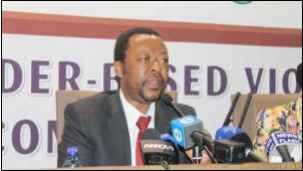 In South Africa a woman is raped every 26 seconds and more than 71 per cent of women have been sexually abused, according to statistics released by the Department. It is hoped that the command centre would help deal with this growing crisis.
In South Africa a woman is raped every 26 seconds and more than 71 per cent of women have been sexually abused, according to statistics released by the Department. It is hoped that the command centre would help deal with this growing crisis.
“For too long, violence against women and children has remained a hidden scandal in our homes and communities. Gender-based violence affects all families in South Africa - rich or poor, big or small,” said director-general of Social Development Coceko Phakade.
The new 24-hour call centre was launched as part of the country’s celebration of 20 years of championing the struggle for gender equality. “Over the past 20 years we have made impressive progress in freeing women from customs and practices that undermine women’s rights,” said Phakade.
More girls are now in school and tertiary institutions and more women have been employed. Yet despite these achievements, Phakade said that gender-based violence remains one of the major challenges facing South Africa today. The Medical Research Council and Gender Links Study of 2011, showed that over half of the women in Gauteng have experienced some form of violence in their lifetime. The study also noted that 78 per cent of men in the province admitted to being perpetrators of violence against women. According to the department, violence against women can be physical, sexual, economic and psychological, all of which violate a woman’s dignity and human rights.
The only way to end the vicious cycle is to empower victims of gender-based violence, which is what the new call centre aims to do. It will provide support and counselling to victims, who will receive immediate psycho- logical assistance and referrals to help them avoid further exposure to violence.
The pilot phase command centre will, for the next six months, operate in Hillbrow, Moroka, Sunnyside, Akasia and Alexandra in Gauteng, as well as Edendale and Inanda in KwaZulu-Natal. However, victims from across the country can also make use of the call centre to get help.
To date, 75 qualified social workers have been employed and trained in trauma management and customer service. Sixty-five of these social workers were previously unemployed. The command centre will also help in prosecuting those responsible for these crimes. The information collected throughout the intervention process can be made available to the courts as evidence.
The department has joined forces with the South African Police Service, Departments of Justice and Constitutional Development, Health and non-government organisations to ensure victims receive medical or legal assistance.
The Vodacom Foundation has also given its support to efforts to stop gender-based violence by investing R4.2 million to help cover the cost of the information communication technology infrastructure for the call centre over the next six months.
“We wanted to get involved in the initiative to ensure victims of gender-based violence have access to qualified help. Gender-based violence is not acceptable in a country where people have equal rights,” said Vodacom’s chief of corporate affairs Maya Makanjee.
The call centre also forms part of government’s interventions to address gender-based violence, which include the establishment of shelters for victims of domestic violence and the Khuseleka One Stop Centres for Victims of Crime and Violence. These centres also provide services such as counselling, medical treatment, legal and police services under one roof in order to minimise victimisation
Victims can call the toll free number on 0800 428 428 (0800 GBV GBV) and will be able to speak to a social worker for assistance and counselling. Callers can also request a social worker from the command centre to contact them by dialling *120*7867# (free) from a cellphone.
Taking justice to the people
Taking justice to the people sadminResidents of Kagiso in Krugersdorp no longer have to take long journeys to neighbouring towns to access justice services
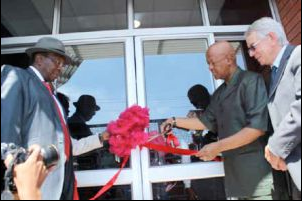 hese services are now close to their homes thanks to the newly revamped Kagiso Magistrate’s Court, launched by Justice and Constitutional Development Minister Jeff Radebe recently.
hese services are now close to their homes thanks to the newly revamped Kagiso Magistrate’s Court, launched by Justice and Constitutional Development Minister Jeff Radebe recently.
“By revamping this court we ensure that the community of Kagiso will no longer suffer the indignity and hardships of having to commute to the far away court in town to access services relating to civil claims, family law, maintenance, deceased estate,” said Minister Radebe.
He added that it was important that justice was felt in all aspects of people’s lives. The new look court forms part of efforts to accelerate access to justice, specifically for people living in townships and rural areas.
The court was previously a branch court, which only dealt with criminal matters like prosecuting criminals. It has now become a full services court and offers a range of services to the Mogale City Municipal District, from maintenance and domestic violence services to a small claims court and children’s court.
The Minister said that through the Access to Justice Programme, the department is ensuring that magistrate’s courts are available in municipal districts. This will speedily transform the justice system and contribute towards building an equal and just society.
To date 35 magistrate’s courts in Gauteng and the North West have been re-aligned to serve specific communities.
“By remodelling the criminal justice system we have now created a criminal justice system that responds to the needs of our democratic society,” said Minister Radebe.
The remodel includes beefing up visible policing, improving crime-fighting initiatives and handing out higher conviction rates and harsher sentences for criminals.
With the adoption of the Civil Justice Reform Programme (CJRP), which was approved by Cabinet in 2010, the department is working hard to ensure a speedy, affordable, simple and accessible justice system to resolve civil disputes in court.
20 years of justice
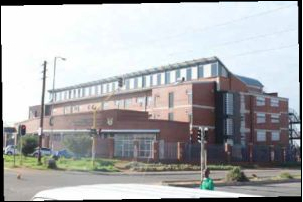 The opening of the court comes at a time when South Africans celebrate 20 Years of Freedom and shows government’s commitment to addressing the inequalities of the past. Since 1994, the department has built 43 new courts, mostly in areas that did not enjoy these justice services before, and revamped others.
The opening of the court comes at a time when South Africans celebrate 20 Years of Freedom and shows government’s commitment to addressing the inequalities of the past. Since 1994, the department has built 43 new courts, mostly in areas that did not enjoy these justice services before, and revamped others.
The Kagiso Magistrate’s Court is the 29th branch court to be converted into a full services court since 1994. Small claims courts in the country have also increased to 293, with 30 established in the current financial year alone and over 1 630 commissioners presided in these courts free of charge. The department’s goal, according to the Twenty Year Review, is to establish a small claims court in every district.
“I am confident that the community of Kagiso will live up to its name which translates to ‘Let there be peace’ in Setswana, and set the trend for peaceful resolutions of civil disputes in our courts,” said Minister Radebe.
For mother of three, Nonthembehle Giyani, the court brings much relief. “I used to spend so much money on transport to go to court for my maintenance claim but now I can just walk from my home and will be at the court in 10 minutes.”
Construction worker Enoch Addis said he hoped the new court would help put away criminals that trouble community for good. “We feel safer and believe that our community will improve because the new court will process more cases quicker.
Housing project brings joy to KZN pensioner
Housing project brings joy to KZN pensioner sadminPensioner Mafiki Mbambo has waited a long time for her dream to come true. At 75, Mbambo finally has a proper house to live in.
The is one of the beneficiaries of the R110 million KwaDube Rural Housing Project in KwaZulu-Natal.
Halfway through the project, more than 700 houses have been completed, giving homes to 1 500 people.
Mbambo believes it’s her vote that helped her get a new house.
“Ever since 1994, I have making sure that I make my voice heard in how I want this country to be governed, even when some of my neighbours were telling me that voting doesn’t help. I think it helped me and today I have a home.”
The overjoyed Mbambo, who hails from Ndindima, near Esikhaleni, says owning a home is a dream come true for her.
She used to live in a shack in an informal settlement and before that home was the mud house her late husband had built.
“During winter it was very cold at times. We had to light a fire in the house, which was dangerous because the house could have burnt down.
“The rainy season was worse because my home would be washed away by the rains and my three children and I would have to rebuild the shack,” she adds.
According to the KwaZulu-Natal Department of Human Settlements, over the past 20 years more than 500 000 houses have been built in the province.
The department has spent close to R500 million in housing projects ranging from upgrading informal settlements, community residential units (formerly single sex hostels) to rural and affordable housing projects.
Nationally, the democratic government has delivered approximately 3.7 million subsidised housing opportunities for the very poor, giving a home to approximately 12.5 million people. This is according to the Twenty Year Review, recently released by the Presidency.
“Fifty-six per cent of all subsidies allocated have been to woman-headed households, engendering housing in South Africa like in no other country,” the review adds. One of those woman-headed households is Mbambo’s.
The new homeowner says she is proud to see the country progress and hopes the next 20 years would bring more development to South Africa.
North West farmers harvesting success
North West farmers harvesting success sadminA new, R20 million programme is providing North West farmers with the post planting resources they need to ensure successful crops.
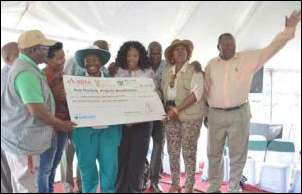 In an effort to sustain crop production in the province, the North West Department of Agriculture and Rural Development, in partnership with the national Department of Rural Development and Land Reform, officially launched the Post Planting Production Inputs Initiative in the Ngaka Modiri Molema District.
In an effort to sustain crop production in the province, the North West Department of Agriculture and Rural Development, in partnership with the national Department of Rural Development and Land Reform, officially launched the Post Planting Production Inputs Initiative in the Ngaka Modiri Molema District.
Just over 100 farmers, who planted 6 335 hectares of maize and 7 373 hectares of sunflower in the Ditsobotla, Ratlou, Tswaing and Mahikeng, will benefit from more than 36 000 litres of diesel, fertilisers, chemicals, top dressing, repairs and maintenance of machinery, payment of casual labourers and costs related to harvesting.
According to the MEC for Department of Agriculture and Rural Development, Desbo Mohono, this initiative will help bring land that been has unused for many years under full production, contributing to food production and food security initiatives in the province.
“It is through this initiative that the potential for these communal farmers to produce for commercial markets could be unleashed, as demonstrated by one dynamic woman beneficiary from Kaalpan, who has put more than 1 000 hectares under production,” said MEC Mohono.
The beneficiaries of the project include individual farmers and seven cooperatives.
Most of the farmers have attended courses and have been trained in soil preparation, mechanisation, top dressing, chemicals and budgeting of finances.
The training has helped them overcome tough times and conditions.
They will also have the opportunity to continue the training through courses at the Kgora Training Institute.
Chief director at the Department of Rural Development and Land Reform, Lengane Bogatsu, said the partnership between the national and provincial departments would grow from strength to strength, to ensure that farmers were well taken care of. “We have many projects of this magnitude within our lucky packet. We will be taking no prisoners when it comes to improving the livelihood of our farmers within the province,” said Lengane.
*Prince Seokotsa works for the North West Department of Agriculture and Rural Development
Clean water for Mbizana residents
Clean water for Mbizana residents sadminNontsapho Faku and other residents of Mbizana in the Eastern Cape have struggled for years to get clean water
 Currently, they rely on the river and temporarily installed taps and sometimes go a week without water.
Currently, they rely on the river and temporarily installed taps and sometimes go a week without water.
All these struggles for clean water will be a thing of the past thanks to the construction of the Ludeke Dam.
“We want water badly in this area. We are struggling to get water. We fetch it from the river and share it with cattle. We are very grateful that we will soon get clean water through the Ludeke Dam,” said Faku.
Ludeke Dam, the second biggest dam in the former Transkei region after Mthatha Dam, is part of the Greater Mbizana Regional Bulk Water Supply Scheme and has a storage capacity of 14.5 million cubic metres of water.
The project includes the construction of Nomlacu Water Treatment Works at a cost of R70 million, where water flows from a pump station at the Ludeke Dam through a 13km of steel pipe to the water treatment works.
The water treatment works is designed to eventually supply 20 mega litres of water per day but currently has a capacity of 10 mega litres (10 million litres) water per day. The plant will ensure that the community gets clean and healthy water.
Another element of the project is a bulk pipe line and the building of reservoirs at a cost of R110 million.
The bulk pipe line will supply water from Nomlacu Water Treatment Works to strategically situated bulk reservoirs areas across Mbizana, which in turn will distribute treated water to the Greater Mbizana area.
Job opportunities
The project has also created job opportunities for local communities.
The Ludeke Dam has created 190 jobs, the pump station has employed about 70 people, Nomlacu Water Treatment Works 70 people and 150 were employed to work on the pipelines. Also, 32 people have been trained as plumbers and five as treatment works operators.
About R6.5 million was spent locally to pro- The newly constructed Ludeke Dam in the Eastern Cape is part of the Greater Mbizana Regional Bulk Water Supply Scheme, which will supply clean drinking water to about 270 000 people.
cure diesel, accommodation, security services, portable toilets and local contractors. “The project has assisted me a great deal. I am now the bread winner at home. I was not employed before,” said Ntombifuthi Cagi, of ward 27, in Mbizana.
She started working at the project in March 2012 as a cleaner.
Once completed, the project is expected to supply safe drinking water to about 270 000 people.
* Ndyebo Kopo works for Government Communication and Information System in the Eastern Cape
New boarding school, new possibilities
New boarding school, new possibilities sadminA new R189 million stateof- the-art boarding school is changing the lives of learners and families in Mpumalanga by catering for orphans, vulnerable children and those from child-headed homes.
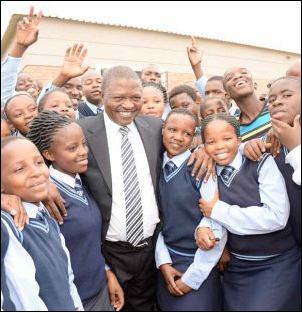 Thanks to the new Izimbali Combined Boarding School, learners from Amsterdam and surrounding areas, no longer have to walk long distances to get to school or go hungry because there is no food at home.
Thanks to the new Izimbali Combined Boarding School, learners from Amsterdam and surrounding areas, no longer have to walk long distances to get to school or go hungry because there is no food at home.
Worrying about how to cope without electricity or clean water is also a thing of the past for these learners.
Izimbali, which means flowers, now houses learners from the neighbouring Idalia, Thokomala, Zandspruit, Lithole, Riverbend, Broadholm, Westoe, Nongena and Samlee villages.
Not only are learners being educated at a fully functioning school but they also have a home to go to at the end of the school day, with a comfortable bed, bathrooms, hot showers and a kitchen that supplies them with three meals a day.
According to the province’s spokesperson, Zibonele Mncwango, the name fits the design and beauty of the boarding school that was handed over by Mpumalanga Premier David Mabuza recently.
“The school was built following a promise made by the premier to phase out multigraded and unsafe schools in the province.” Izimbali is one of four boarding schools established in the province to ensure that learners from rural communities including farms, are able to access the quality education they deserve.
Construction of the school started in 2012 and it now boasts 24 spacious classrooms, a science laboratory, library, computer centre and dormitories.
What makes the school different, says Premier Mabuza, is that learners finally have a home, food in their stomachs and are safe. Many learners also used to help their families herd cattle because their parents In an effort to improve the mathematics and science results of South African learners, the Department of Basic Education is drawing on the experiences of China. The two countries will strengthen educational ties after an implementation plan was recently signed by Basic Education Minister Angie Motshekga and Chinese Minister of Education.
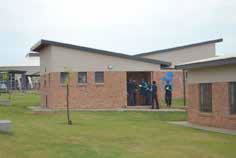 South Africa will look to learn lessons from China in curriculum development, mathematics, science, technology as well could not afford to send them to school. “This is why it was so important to build the school near the farms,” he said. The new no-fee school is part of the province’s Corporate Rural Development Programme, which is ensuring that vulnerable children, such as orphans and those from child-headed families, are given the required support and a new lease on life through education. “As the country celebrates 20 Years of Freedom and democracy, we are giving the freedom of education to these children. We believe that no child should be deprived of education. These children now have a chance at a better future,” said Premier Mabuza.
South Africa will look to learn lessons from China in curriculum development, mathematics, science, technology as well could not afford to send them to school. “This is why it was so important to build the school near the farms,” he said. The new no-fee school is part of the province’s Corporate Rural Development Programme, which is ensuring that vulnerable children, such as orphans and those from child-headed families, are given the required support and a new lease on life through education. “As the country celebrates 20 Years of Freedom and democracy, we are giving the freedom of education to these children. We believe that no child should be deprived of education. These children now have a chance at a better future,” said Premier Mabuza.
The new school, which accommodates learners from Grade R to 12, has opened up a world of knowledge and possibilities for learners who walk through its doors. Many of the learners had never even read a library book before but now have a lifetime of stories at their disposal.
“My favourite part of the school is the library. The books are all new and not torn or dirty. I love reading so I go there in my free time. I would sleep there if I could,” said an eight-year-old learner.
With not many school uniforms in their wardrobe, many of the older learners would go home from school to wash their uniforms and that of their siblings.
This is no longer a concern for learners as they each have new uniforms and the school boasts an impressive laundry facility. “This allows children to be children and solely focus on enjoying learning, playing sport and concentrating on their schoolwork,” said Mncwango.
FET colleges tackle HIV and AIDS
FET colleges tackle HIV and AIDS sadminAt least 650 000 students at Further Education and Training (FET) colleges in the Free State are expected to benefit from the Higher Education Aids (HEAids) programme launched in the province recently.
The HIV and AIDS awareness project was first introduced by the Department of Higher Education and Training in 2012.
It aims to fight the spread of the disease through information, testing and counselling of thousands of college students.
The programme initially targeted universities but is now being rolled out to FET colleges.
In Bloemfontein, the programme was launched at the Motheo FET College. Free State HEAids coordinator Pakiso Thulo told hundreds of students at the college that the programme included pre- and post HIV testing and counselling. “The programme also seeks to empower female students to have negotiating powers with their sex partners about the use or non-use of condoms during intercourse … Motheo is making history today by being the first college in the country where the programme is launched,” said Thulo.
Free State Department of Education director Bob Tladi welcomed the programme.
He said it would encourage responsible sexual behaviour among FET college students in the province and contribute to the reduction of HIV infections among young people.
Tladi said the programme would reach the 650 000 students registered at the four FET colleges in the province this year and was also expected be rolled out at the Goldfields Flavius Mareka College and Maluti FET colleges
China to give SA lessons in maths, science
China to give SA lessons in maths, science sadminIn an effort to improve the mathematics and science results of South African learners, the Department of Basic Education is drawing on the experiences of China
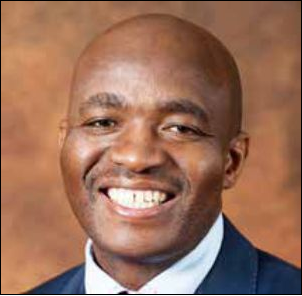 The two countries will strengthen educational ties after an implementation plan was recently signed by Basic Education Minister Angie Motshekga and Chinese Minister of Education.
The two countries will strengthen educational ties after an implementation plan was recently signed by Basic Education Minister Angie Motshekga and Chinese Minister of Education.
South Africa will look to learn lessons from China in curriculum development, mathematics, science, technology as well as teacher training and development.
The department’s deputy director-general Mathanzima Mweli will lead a delegation, which will include specialists in vocational education, mathematics, science and teacher development, to China.
“What we would like to learn from China is how learners were able to do so well in these areas,” he explained.
Mweli said currently China was putting together its own resources to teach mathematics, science and technology.
“We would like to also build capacity to generate our own resources just as we are doing with the work books… We will be looking at what incentives they offer for teachers and learners,” he added.
Producing artisans is a priority for South Africa and it is the Department of Basic Education that is responsible for laying the foundation for vocational education.
Mweli explained that the department was in the process of reviewing the national curriculum statement to improve the split between the academic and vocational streams with the aim of encouraging more schools to offer vocational subjects.
China has already succeeded in achieving Basic Education deputy director-general Mathanzima Mweli says South Africa has a lot to learn from China, especially when it comes to mathematics and science.
a 50- 50 split in this regard and South Africa wants to learn from China’s experience, he added.
The agreement includes a cultural exchange element and will also see the Chinese language, Mandarin, being taught in South African schools.
The Chinese government will develop a curriculum to teach Mandarin and the language will be offered at some schools that have the capacity to teach it.
He said China also had lessons to learn from South Africa, where access to education is currently at 98 per cent.
“The Chinese would look at what incentives we developed in access to education such as providing meals at school, the school transport programme and having no-fee schools.”
The lessons learnt from the Chinese education system will first be introduced in 500 poor performing schools and 200 technical schools before expanding to other schools in the country.
Mabopane student to jet off to space
Mabopane student to jet off to space sadminYouth matters
Engineering student and part-time DJ Mandla Maseko is set to become the first black African to venture into space.
 he 25-year-old, from Mabopane in Pretoria, will have the chance of a lifetime when he spends an hour in space on the Lynx Mark II Shuttle in 2015.
he 25-year-old, from Mabopane in Pretoria, will have the chance of a lifetime when he spends an hour in space on the Lynx Mark II Shuttle in 2015.
Maseko’s journey to space started when he entered the Axe Apollo Space Academy competition in August last year.
“I was on the couch at home when I heard a radio advertisement calling for people to enter a competition to win a trip to space,” he explained.
Maseko entered the competition, along with hundreds of other South Africans and had to send in a photograph of him in mid-air and explain why he wanted to go to space.
He sent a picture of himself jumping off a two-metre wall in his backyard. His explana tion read: “I want to defy the laws of gravity and go down history as the first black South African in space.”
His entry was one of 30 selected to compete in the first set of challenges at a space camp in the Free State. In one of the challenges Maseko had to skydive off a plane at 10 000 feet.
Maseko made the cut, together with Dean Roddan and Haroon Osman from Johannesburg and went to the Kennedy Space Center in Orlando, Florida in December last year.
The three competed in the next round of gruelling challenges with 109 other competitors from across the world.
Here he endured battling G-force in a “vomit comet”, conquered obstacle courses and had to build and launch a rocket.
“We had to do air flight simulation, air combat and a zero gravity flight. You name it, I completed it. Unfortunately we could not get our rocket to launch but we earned points because we were judged on bravery, enthusiasm and teamwork,” said Maseko. Asked about the “vomit comet”, Maseko explained, it was a room that started spinning and where the floor disappeared.
“You end up being pushed against the wall by G-force and the challenge was I had to pick up five flags under me and place them above my head. I nailed it.”
Maseko and the five other finalists then headed to the plane stunt. “We were taken up in a plane to about 4 000 feet (1 219 metres) above the ground and had to sit steady while the pilot did a few manoeuvres like turns, twists and loops. It was incredible.”
After a final written test, Maseko was announced as one of the 23 winners from across the world by legendary spaceman and competition judge Buzz Aldrin, who was the second man to walk on the moon. On graduation day at the space centre, Maseko heard the news that former President Nelson Mandela had died. “At that moment I felt the sense of h i m handi n g me the t o r c h and telling me to continue. I knew I had to keep at it and do my best to make him proud.”
Maseko’s trip to Florida was the first time he had been out of the country.
“I am a typical kasi (township) boy so I had not travelled a lot but I knew I was destined for greatness,” he said.
Maseko added that he had always felt t h a t it was his duty to do the best he could to inspire those around him.
To help empower local youth, Maseko has joined the Department of Science and Technology’s education drive and visits schools across the country to motivate youth.
“This is what I am meant to be doing and one day people will be telling their children and grandchildren that I was the first black South African in space.”
Maseko will be the second South African, after billionaire Mark Shuttleworth, to travel to space.
Age is no limit for Dr Kubheka
Age is no limit for Dr Kubheka sadminAt just 20 years old, Sandile Kubheka from KwaZulu-Natal is the youngest doctor in the country.
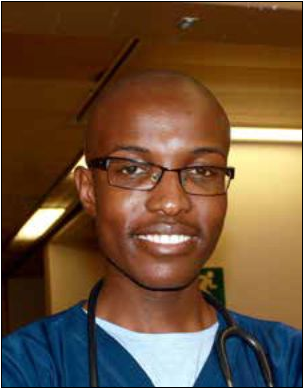 The shy, yet brilliant young man started school at the age of five and has excelled in the classroom since then. After just three months in Grade 6 at the Jobstown Primary School in Masondeza, Madadeni, he was promoted to Grade 7
The shy, yet brilliant young man started school at the age of five and has excelled in the classroom since then. After just three months in Grade 6 at the Jobstown Primary School in Masondeza, Madadeni, he was promoted to Grade 7
“School work was so easy. I was able to grasp information and recall it very quickly, which made me breeze through school,” he says.
He was 15 when he matriculated from Siyamukela High School, also in Madadeni and started studying towards a degree in Medicine and Surgery (MBChB) at the University of KwaZulu-Natal’s Nelson Mandela School of Medicine.
He completed his degree last year, making him the youngest medical graduate in the country. “When I first heard that I was the youngest graduate, I could not believe it. I was very honoured,” he says.
Kubheka graduated with distinctions in ob- stetrics and gynaecology.
Despite excelling in the classroom, Kubheka admits that being the youngest in the class came with its fair share of problems.
“I was confronted with social issues like my friends going out and drinking alcohol. Academically we may have been on the same wave length but socially I was very young.” The biggest challenge, he says, was learning cook, clean and budget his finances.
“I came from a home where I didn’t have to wash my own clothes, cook my own food or worry about budgeting my money for the month. In the beginning my sisters would laugh at me because I was young and they said I could not take care of myself. It was tough but I have grown and learnt a lot.”
Kubheka’s age earned him the nickname ‘neonate’ (meaning a newborn) from his classmates. However, this did not deter them from voting Kubheka as most likely to be the Minister of Health one day soon.
“If it allows me to continue making a difference and improving health care for all South Africans, then yes, being Health Minister one day would be a dream come true,” he says.
A passion for helping others led Kubheka to the medical profession and keeps him focused. This, he says, was passed on to him by his mother Khangezile, who raised him and his four older siblings on her own.
“She always taught us to do our best in everything and to be grateful and grounded.”
While at medical school, Kubheka chose to serve on the Rural Development Club, and the Medical Student’s Representative Council. Kubheka also gave free medical advice and treated patients in rural communities at the Happy Valley Clinic and the Madadeni Hospital. These efforts earned him the Yashiv Sham Bursary for having compassion and caring qualities and the Enid Gordon Jacob Good Fellowship Prize for character and good conduct.
“Giving back to my community is very important to me,” he says.
Currently, Kubheka is completing his internship at three hospitals - Grey’s, Edendale and Northdale in Pietermaritzburg.
His goal is to complete his Master’s degree and become an endocrinologist - a specialised doctor who studies diseases that affect the glands.
Kubheka’s advice to the youth is to always be focused and give their best. “No matter how young or old you are, never give up,” he adds
Higher Education South Africa
Higher Education South Africa Estelle GreeffHigher education
 In 2013 South Africa welcomed 2 brand new public universities, expanding the total number of universities you can choose from to 25. So now there is at least one university in each of the 9 provinces. In order to make a well-informed decision on the university best suited for you, you need to conduct extensive research by attending universities’ open days, visiting companies and practitioners within your field of interest, and seeking advice from your parents, teachers, or guardian as soon as possible
In 2013 South Africa welcomed 2 brand new public universities, expanding the total number of universities you can choose from to 25. So now there is at least one university in each of the 9 provinces. In order to make a well-informed decision on the university best suited for you, you need to conduct extensive research by attending universities’ open days, visiting companies and practitioners within your field of interest, and seeking advice from your parents, teachers, or guardian as soon as possible
Minimum admission requirements
In order to be admitted into any specific university course, you need to have a specific combination of school subjects. As such it is important when choosing your school subjects in grade 10 to have an idea of the field of study (and ultimately the career) you intend to pursue post-school.
In addition to choosing your subjects carefully, you also need to ensure that you obtain the minimum marks necessary for admission into the specific field of study you are interested in. So, remember to work to the best of your abilities consistently throughout the year, so as to give yourself a good chance of being admitted into your preferred field of study, particularly into programmes which have competitive selection. Believe in yourself, and work very hard towards your dreams.
Apply now
Remember to apply as soon as possible, and no later than 30 September 2014 for 2015 university admission. University courses have different closing dates. Contact the university of your choice for information on the application process.
For more information
Visit our brand new and exciting website www.nishe.org.za which will be going live at the end of June 2014.
For any queries
- SMS your age, town, & query to 47989 (R1.50/SMS)
- Email us on info.nishe@hesa.org.za
Chicken business puts businesswoman on the map
Chicken business puts businesswoman on the map Estelle GreeffFour years ago, Livhuwani Tshifango took a big gamble when she swapped her business suits and heels for chickens.
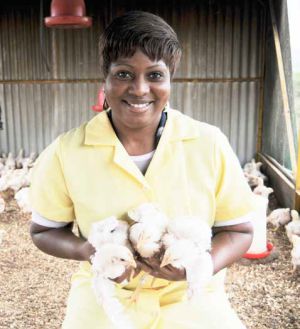 The former bank administrator left her job to start a chicken abattoir, a decision she does not regret.
The former bank administrator left her job to start a chicken abattoir, a decision she does not regret.
“People always ask me why I left my job and sometimes it’s difficult to answer that. I feel like this is my calling,” says the 34-year-old.
She spent six years at ABSA as a branch administrator before joining Standard Bank, first as an administrator and later as a consultant at the enquiry desk.
According to Tshifango, it was her clients who contributed to her decision to resign. “Most of the people I helped at the bank had a farming background and they had a lot of money in their accounts.
“It was then that I decided to get into this kind of business and I’m happy. I don’t have any regrets about leaving my job.”
After resigning in 2010, Tshifango used her pension fund to start a small cooperative in Makhado, Limpopo, which she called Khariye Poultry Farming.
“I invested about R80 000 in the cooperative. My younger brother also became involved in the cooperative,” she adds.
The cooperative has since created 27 jobs for locals. It raises, slaughters and packages chickens to sell to retailers, hawkers, local communities and restaurants in and around Makhado. The cooperative also sell live chickens.
Tshifango says her business journey has been filled with challenges. When the cooperative started, it did not have electricity, running water or a place to slaughter the chickens.
Instead of setting her back, these challenges made her more determined.
“Those challenges did not deter me from working hard because I knew that the road would not be easy. I wanted to succeed and every obstacle that came my way just motivated me to work harder.”
Unpredictable weather also proved to be a huge challenge for Khariye Poultry Farming. In December of 2013, heavy rains and storms caused havoc in the region and killed more than 300 chickens.
“When I see chickens, I see money and when those chickens were killed, I went into a corner and cried because I had lost a lot of money,” she recalls.
With the help of a grant from the Department of Agriculture, the cooperative was able to build two additional structures to house the chickens and as a result their cooperative has grown significantly.
The cooperative slaughters more than 1 000 chickens a month and demand increases during peak periods. “During times like Easter, the demand increases and that’s when we slaughter even more,” she explains.
Khariye Poultry Farming was the overall winner of the Eskom Business Investment competition, an initiative of the Eskom Development Foundation, and walked away with R200 000.
The cooperative was recognised and rewarded for its solid business model and financial management, as well as its contribution to addressing unemployment in the area.
The cooperative also named the best agricultural project in the Vhembe District Municipality in Limpopo.
Although Tshifango and her team are not supplying any of the major supermarkets, she says her supplier database is good and hopes to increase it.
“Currently, we are supplying the community, stokvels, small retailers and small restaurants in Makhado. I’m confident that as the business grows, we will get the bigger contracts and supply other big shops,” she says.
With the prize money from the Eskom Business Investment competition the cooperative plans to expand their business to produce more chickens and meet the ever-increasing demand, with the long-term goal to distribute the chickens countrywide.
Farm workers wages increased
Farm workers wages increased Estelle GreeffFarmworkers can look forward to a little more money in their pockets after the minimum wages for vulnerable workers in the farms sector was increased from 1 MAY 2014.
"In terms of sectoral determination for farm workers, the minimum wages will be adjusted upwards to an hourly rate of R12.41 (previously R11.66); a weekly rate of R558.60 (from R525), and monthly minimum wages of R2 420.41 (from R2 274.82),” the Department of Labour announced.
Sectoral determination covers the protection of workers in vulnerable sectors/areas of work. The determination sets minimum working hours, minimum wages, number of leave days and termination rules.
The determination is reviewed annually by the Labour Minister. The new determination will be effective until the end of February 2015.
Godisa Fund to boost small businesses
Godisa Fund to boost small businesses Estelle GreeffBlack-owned small businesses will receive a major cash injection as government steps up efforts to support them.
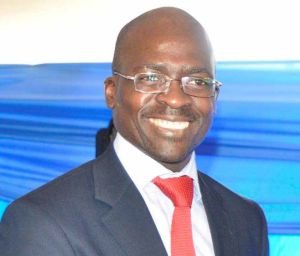 The launch of the Godisa Supplier Development Fund will see R165 billion spent on financial and non-financial support to businesses owned by black people.
The launch of the Godisa Supplier Development Fund will see R165 billion spent on financial and non-financial support to businesses owned by black people.
“The Godisa Fund is a R165 million fund that is set up with contributions from Small Enterprise Finance Agency (Sefa), Transnet, and Anglo American’s (enterprise development arm) Zimele. We came together, we each put [in] a bit of money and we said let’s identify small businesses that can help supply Transnet,” said Public Enterprises Minister Malusi Gigaba at the official launch of the fund.
Small black-owned businesses will get the necessary support to help them provide services and manufactured goods to Transnet.
Minister Gigaba said the fund would also help small business deal with the challenges they face, especially in the first few years of existence.
“In South Africa, we have almost five million small and medium entrepreneurs and 70 per cent of them do not survive beyond 18 months due to structural problems, which include lack of access to funding, which is a serious economic efficiency. It is something that our economy will not self-correct.”
The Minister called on young black people to take advantage of the opportunity and apply for funding.
He congratulated Transnet, Anglo-American and Sefa for setting up the fund.
“We need to increase our appetite for risk, take a handholding approach and trust black people as capable entrepreneurs so that we don’t build the economy on the back of fronting entrepreneurs with no experience or skills,” the Minister said.
To apply for the funding, business owners need to submit an investment proposal, together with a formal business plan. Once evaluated, potential recipients will have to present their business case to a committee consisting of the fund manager, among others.
To qualify for Godisa funding, applicants have must be a small business, it must be black-owned and be able to render a service to Transnet. Interested businesses can contact Sefa on 086 000 7332 or go to www.sefa.org.za for more information.
Energy-saving baking brings in extra dough
Energy-saving baking brings in extra dough Estelle GreeffFour Mpumalanga women have found an awardwinning way to reuse energy to bake bread and buns for their township customers
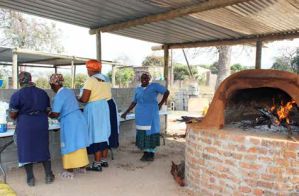 The women, who run Vuka-uzenzele Project, work as volunteer cooks for the Sehlulile Primary School feeding scheme in Matsulu, east of Mbombela. “After cooking for the children and serving their meals, the clay oven is hot enough for us to remove the ashes and start baking for as long as we want without burning our bread,” said project member Lindiwe Nkosi.
The women, who run Vuka-uzenzele Project, work as volunteer cooks for the Sehlulile Primary School feeding scheme in Matsulu, east of Mbombela. “After cooking for the children and serving their meals, the clay oven is hot enough for us to remove the ashes and start baking for as long as we want without burning our bread,” said project member Lindiwe Nkosi.
Nkosi said the oven was built by pupils at the school as part of the feeding scheme.
The women soon realised that the oven remains hot long after they are done cooking. “We were sitting under a tree when we realised that the oven retained a lot of energy after we have cooked. We realised that together we can bake bread, scones and buns to sell to the teachers and community by using the same methods as our ancestors.
“We don’t spend money on wood as it is delivered at the school for free and we wait until we are done cooking before we start baking. We are also humbled by the support from the teachers as it encourages us to work hard,” said Nkosi.
The clay oven can accommodate 10 bread trays, which is enough to make them a profit. Nkosi has even calculated how much money they save by using the clay oven.
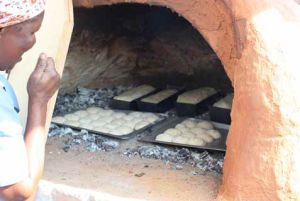 “We bake four times an hour every day and this method saves 380kWh and R228 a month when compared to using a conventional oven. “We are preventing 4 468.8kg of carbon dioxide being released into the atmosphere every year,” she added.
“We bake four times an hour every day and this method saves 380kWh and R228 a month when compared to using a conventional oven. “We are preventing 4 468.8kg of carbon dioxide being released into the atmosphere every year,” she added.
The project’s efforts to save energy did not go unnoticed.
They were runners-up at the Eskom eta Awards in the community category.
The purpose of the awards, which are named after the Greek symbol of efficiency, is to reward exceptional efforts in efficient use of energy by individuals, students, companies or other institutions.
Vuka-uzenzele Project won R5 000, which they plan to re-invest in the project.
“Since we work as volunteers at the school, the project helps us maintain our families and also put food on the table,” said another project member Norah Sibiya
Lights, camera, action in Diepsloot
Lights, camera, action in Diepsloot sadminAspiring filmmakers in Diepsloot, north of Johannesburg, now have a real shot at making their movie dreams come true, as the first film studio opened its doors in the township recently.
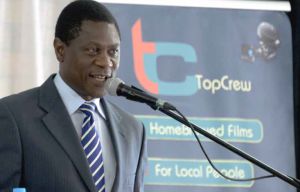 The Department of Arts and Culture has partnered with Top Crew Home Brew Movies - a 100 per cent blackowned holding company that produces local movies - to make the studio a reality. The department has put R1.5 million into the Top Crew Film training programme, which will give youngsters like Marcia Mankhense a chance to be in show business.
The Department of Arts and Culture has partnered with Top Crew Home Brew Movies - a 100 per cent blackowned holding company that produces local movies - to make the studio a reality. The department has put R1.5 million into the Top Crew Film training programme, which will give youngsters like Marcia Mankhense a chance to be in show business.
“I want to be an actress because it’s been my dream since childhood. I’ve always wanted to see myself on TV. I’m thankful to government for giving us this chance and believing in us,” she said.
Shandukani Mashatana is equally passionate about wowing audiences and dreams of performing, saying he wants to be “the best actor and comedian”.
Mankhense and Mashatana are two of 70 young people, who received training through the Top Crew Film training programme. They will continue to make movies as part of the programme.
This group of young filmmakers is not the only one standing at the shore of a sea of big, dazzling dreams - a fact that the department is awake to. With this in mind, the training programme will also be hosted in other provinces.
Arts and Culture Minister Paul Mashatile said the training programme, which helps communities get involved in the lucrative R5 billion a year film industry, will also contribute to the generation of local content for use on community television stations.
The studio will help the world to see Diepsloot through a different lens.
“Diepsloot should no longer be seen as a notorious area where children are raped and murdered, but as a model of a society that is producing actors and actresses, who will be making South Africa’s film industry vibrant.
“With the opening of this studio, gone are the days where people would not dare to visit this area… You must produce the best actors so that people will always flock to the township in their numbers,” the Minister said, while handing over the studio to the community.
The studio is located at the settlement’s Youth Community Centre.
True story
The minister urged residents to use the film studio to produce movies that tell authentic South African stories.
“The world is hungry to hear our stories; stories of a nation that has overcome adversity; stories of a resilient people; stories of reconciliation and stories of how together we are building this nation on the foundation laid by giants such as the founding father of our nation, Nelson Mandela.
“We are providing them with access to resources and skills to create their own movies and tell their own stories in the languages of their choice. We are providing them with an opportunity to narrate their individual and community experiences from their own perspectives through the medium of film,” said Minister Mashatile.
Growing the local film industry
Minister Mashatile also committed to create opportunities for the local film industry to be showcased on major world stages such as the Cannes Film Festival and the Durban International Film Festival.
“There is nothing stopping us from taking films made here in Diepsloot, at this studio, to Cannes. We say this because South African talent, including talent from Diepsloot, can match the best in the world.”
Equally important to the process of growing the local film industry, is nurturing a love of movies in communities. The Minister has a plan on how the department and filmmakers will achieve this.
“Our audience development initiatives include efforts to bring back the old culture of bioscopes in our communities,” he said. He described the establishment of the film studio in Diepsloot as a worthy investment in young people and the future of the arts in the country. It is also a vote of confidence in the talented youth of Diepsloot by government.
Member of the mayoral committee for environment and infrastructure in the City of Johannesburg, Chris Vondo, said: “What is key for me is the negative image of this community … but all that is going to change because when actors in the community get exposed at national and international level, film producers will come to the settlement to search for talent.”
Support for the studio is in line with the department’s Mzansi Golden Economy Strategy, which seeks to promote arts and culture, contribute to skills development and create sustainable livelihoods
New grant for youth jobs
New grant for youth jobs Estelle GreeffBusiness owners who employ young people can now apply for a grant under a new wage incentive
The Employment Tax Incentive Act, signed into law at the end of last year and effective from January 2014, provides for a wage subsidy that aims to increase employment of inexperienced people between 18 and 29 years.
Under the new legislation, employers can claim back up to 50 per cent of the remuneration of employees. Only employers with staff in this age bracket, who earn less that R6 000, qualify for this incentive.
The incentive is open to all employers except government departments, municipalities, public entities and organisations not registered for Pay-As-You-Earn (PAYE) and will be administered by the South African Revenue Service (SARS).
The incentive will best suit business owners who employ staff with entrylevel salaries of between R2 000 and R4 000, because the incentive becomes progressively less as an employee approaches the salary ceiling of R6 000 per month.
A business employing a qualifying employee at R5 800 per month would only be able to claim R100 per month in the first year, whereas a business employing four qualifying staff who each earn R4 000 a month can afford to employ a fifth person for “free” using the incentive to pay for the fifth employee’s salary.
Employers can claim the incentive in respect of qualifying employees for a period of two years. However, the incentive’s value halves in an employee’s second year of employment, and the incentive falls away at the start of the employee’s third year of employment.
Neren Rau, the CEO of the South African Chamber of Commerce and Industry (Sacci), advises business owners to use the incentive to train and up skill staff, not to employ people only for the sake of qualifying for the incentive. “Although the incentive is not a permanent
thing, business owners need to employ these people full-time and not just for the duration of the scheme. “Business owners who did this would lose out on the training, time and money they had invested in these employees, and could possibly lose key staff to competitors.”
He believes that small businesses will benefit most from this incentive scheme. “We are expecting the service and retail sectors to benefit most and hope that manufacturers will also take advantage of this by employing interns,” says Rau.
However, he says it is important to note that this incentive is meant to kickstart employment and not a permanent> incentive.
Article first appeared in Small Business Connect.
Atchar spices up business owner’s life
Atchar spices up business owner’s life Estelle GreeffFor a long time Tshepo Makwela and his wife were struggling to make ends meet while depending on his salary as a geography teacher.
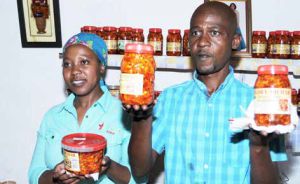 After going through financial problems and 18 years of teaching, Makwela quit his job to start an atchar factory in Flora Park, Limpopo, which he named MacFlora Atchar.
After going through financial problems and 18 years of teaching, Makwela quit his job to start an atchar factory in Flora Park, Limpopo, which he named MacFlora Atchar.
Though the journey has been filled with challenges, Makwela worked hard to improve the situation of his family.
Three years later, he has a thriving business and employs nine locals. He is now supplying Spar in Polokwane and he will be exhibiting his products in Singapore, Poland and India. “When I started this business it was because of the pressure I was under. My wife was not working and we were finding it difficult to cope as a family. We decided to do something about our situation and started making atchar,” he explained.
Makwela’s business got a major financial boost when the Eskom Development Foundation injected R10 000 into it.
He won the R10 000 after he was named as one of the finalists in the Eskom Development Foundation competition.
Makwela said he is grateful to the foundation for giving his business the platform to do bigger things.
“All along I have been using my bakkie but through the success of the business we have been able to buy a bigger bakkie and a truck. “We will be able to create 70 jobs thanks to a contract with two major shops to supply the whole country,” he added.
Makwela’s business was also profiled on the television programme Rize Mzanzi.
He said this exposure helped grow his business and he was also invited by the Department of Trade and Industry to an exhibition in Zimbabwe. Makwela will also soon be exporting atchar to Paris.
He said the world of business was very challenging.
“The message for aspiring entrepreneurs is that hard work pays off. I started my business with R800 and today is worth millions because of working hard and the good exposure,” he added.
SA’s top teachers applauded
SA’s top teachers applauded sadminThe country’s top teachers were rewarded for their hard work and dedication by the Department of Basic Education at the National Teaching Award s recently.
President Jacob Zuma was among the first to congratulate the winners, saying education was a priority and teachers had an important role to play in the lives of learners.
“Education is a ladder out of poverty for many of our children who come from poor households. We rely on our teachers to assist learners to use education to uplift themselves, to fulfil their dreams and achieve their full potential, for the benefit of the country,” he said.
The President added that the hard work and commitment of those teachers nominated for the awards had given the country a good story to tell.
“Our country has a bright future because there are teachers like you, who turn schools in productive centres of learning and achievement,” he said.
Winners received a laptop, an interactive white board, a projector, printer, 20 student headsets, 20 touch screen laptops for their learner, free Wi-Fi connectivity for two years, along with educational content and programmes.
Lifetime Achievement in Teaching: Thinus Coetzee of The West Rand School, Gauteng
Thinus Coetzee is the principal of The West Rand School and has been a member of staff since 1981.
He started teaching at the school, which caters for Learners with Special Education Needs (LSEN), fresh out of college and despite a number of opportunities to move on, has never left.
“During my final year of studies I was exposed to remedial teaching and physical training and it just so happened that the West Rand School was looking for someone with those interests to join the team,” says Coetzee.
“In those days the attitude to LSEN was worlds apart from where we are today but luckily I was exposed to a LSEN centre while growing up so I embraced the school and all the challenges that came with it,” he adds.
Coetzee lives on the premises and coaches archery, cricket, soccer and assists in the supervision of the learner hostels.
Excellence in Special Needs Teaching: Colleen Smit of ES Legrange LSEN School, North West
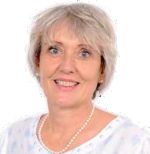 Colleen Smit teaches at the Adult Basic Education and Training (ABET) centre at the ES Legrange LSEN School for the severely intellectually disabled.
Colleen Smit teaches at the Adult Basic Education and Training (ABET) centre at the ES Legrange LSEN School for the severely intellectually disabled.
She joined the school in 2011 and is responsible for teaching learners between the ages of 16 and 21.
“I have always loved kids and have been involved in education for 11 years now,” she says.
Smit adds that the key to teaching LSEN is understanding that they just want to be accepted for who they are.
“To me the most rewarding aspect of my work was when one of my ABET learners became the first LSEN learner to get a level 1 certificate. To my knowledge it had never been done before and I was glad I could play even a small role in that moment.”
Excellence in Primary School Teaching: Jenne Roodt of Laerskool Protea Park, North West
 When Jenne Roodt was four years old, she told her mother that she was going to be a teacher.
When Jenne Roodt was four years old, she told her mother that she was going to be a teacher.
When she finished school she studied psychology but soon found that the pull of the classroom was too strong to resist.
“I was born to teach and within a few months I realised that psychology wasn’t for me and I switched to my first love,” explains Roodt.
She has been teaching at Laerskool Protea Park in Rustenburg for 10 years and started an entrepreneurship initiative at the school, which encourages learners to create products that they can sell.
Excellence in Science Teaching: Wendy Horn of The Settlers High School, Western Cape
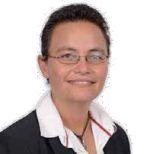 Wendy Horn has been teaching at The Settlers High School in Cape Town for 21 years and currently teaches physical science to Grade 10-12 learners.
Wendy Horn has been teaching at The Settlers High School in Cape Town for 21 years and currently teaches physical science to Grade 10-12 learners.
“I am passionate about my subject, teaching and making a difference. I get to school at 6.30am and offer afternoon classes two days a week as well.”
Horn’s goal is to not only prepare learners for the matric exams but for careers in science as well.
“South Africa needs maths and science graduates so I must prepare them to assume the role of building our country,” she says.
Excellence in Technology- enhanced Teaching, Rametsi Senoamadi of Randfontein High School, Gauteng
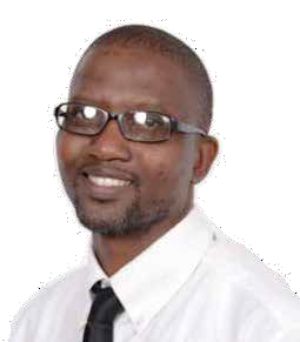 Rametsi Senoamadi became a teacher to make a difference in his community. He has been in the profession for 12 years and currently teaches natural sciences to Grade 9 learners at Randfontein High School.
Rametsi Senoamadi became a teacher to make a difference in his community. He has been in the profession for 12 years and currently teaches natural sciences to Grade 9 learners at Randfontein High School.
Senoamadi is using technology to equip his learners.
“Technology really is the future. I have created a website where I upload all activities for my learners. There is also a Facebook group with quizzes, which allows for interaction. I allow my learners to use their cellphones for internet research and we also do all experiments online before doing them in the classroom,” he explains.
He says these methods have helped improve learners’ attendance and performance
Excellence in Secondary School Teaching: Antonio Audonis of Mondeor High School, Gauteng
 Antonio Audonis has been a teacher for 15 years and currently teaches life sciences to Grades 8-12 at Mondeor High School in Johannesburg.
Antonio Audonis has been a teacher for 15 years and currently teaches life sciences to Grades 8-12 at Mondeor High School in Johannesburg.
He is the head of department of life sciences, physical science and natural sciences. Audonis played a role in learners at the school achieving a 98.5 per cent matric pass rate in 2013.
“I love teaching because it opens doors for children... It’s really the biggest gift you can give a child.”
After all this time, Audonis said he still wakes up in the morning excited to go to class.
“The key is maintaining good relations with my learners and I try to offer extra lessons and support wherever possible.”
Excellence in Maths Teaching: Freddy Marubini of Tengwe High School, LIMPOPO
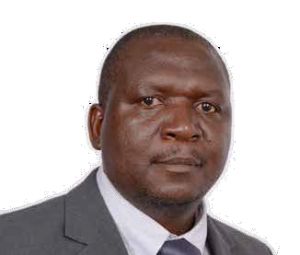 Freddy Marubini has had a passion for mathematics since high school.
Freddy Marubini has had a passion for mathematics since high school.
“In Grade 11 I realised that I was doing well at mathematics, thanks mostly to my great teacher…He would often let me help him teach the class. This sparked an interest within me and I knew then that I would become an educator,” explains Marubini, who has been teaching since 1999.
He currently teaches Grade 12 mathematics at Tengwe High School where he is the head of department for mathematics. Under his guidance 20 learners achieved distinctions in mathematics in the 2013 matric exams.
“The key to teaching is to make sure that all the learners understand exactly what you are saying when you are explaining a concept,” he says.
Excellence in Grade R Teaching: Abegail Makumela of Hopewell Primary School, KwaZ ulu- Natal
 Abegail Makumela has been teaching Grade R learners at Hopewell Primary School in Pietermaritzburg for five years and has been in the profession for 12 years.
Abegail Makumela has been teaching Grade R learners at Hopewell Primary School in Pietermaritzburg for five years and has been in the profession for 12 years.
She started working at a pre-primary school and then did an early childhood development course, which was followed by a degree in education in foundation phase teaching.
“I was working while studying and was approached by a school to teach Grade 1. I lasted in that position for just two months as I missed my young ones too much,” says Makumela.
President Zuma’s Angola visit productive
President Zuma’s Angola visit productive sadminPresident Jacob Zuma has described the mini summit of the Inte r national Conference of the African Great Lakes Region (ICGLR), which he attended in Angola recently, as a positive and constructive engagement.
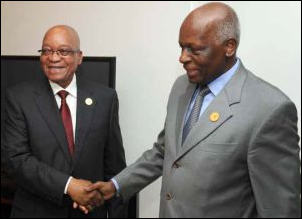 The summit was successful and we have registered positive progress since the previous ICGLR ordinary summit in January 2014. We have discussed and reviewed in detail the overall security situation prevailing in the Great Lakes Region and in Southern Africa and have agreed on necessary measures,” the President said.
The summit was successful and we have registered positive progress since the previous ICGLR ordinary summit in January 2014. We have discussed and reviewed in detail the overall security situation prevailing in the Great Lakes Region and in Southern Africa and have agreed on necessary measures,” the President said.
The summit discussed and agreed on various critical security issues affecting particularly the Democratic Republic of Congo (DRC) and the entire Great Lakes Region.
South Africa, as a signatory to the Peace, Security and Cooperation Framework for the DRC and a member of the Regional Oversight Mechanism, has echoed its support to the efforts of the ICGLR at seeking a lasting political solution in the Great Lakes Region. This is in line with SA’s foreign policy, which promotes a peaceful resolution of conflicts and discourages unconstitutional changes of government.
The relations between South Africa and the Republic of Rwanda were also discussed at the summit, which was also attended by Rwandan President Paul Kagame.
President Zuma was accompanied by Minister of Defence and Military Veterans Nosiviwe Mapisa-Nqakula and Minister of State Security Siyabonga Cwele.
Everyone has a story to share
Everyone has a story to share sadminThis year marks an important milestone in the history of the country as South Africans celebrate 20 Years of Freedom.
A lot has happened in the country over the years. There has been massive infrastructure development, people of different races are able to live side-by-side and lives have been transformed.
As part of the celebrations to mark 20 Years of Freedom, Government Communications and Information System (GCIS) has planned a “Tell your Story” campaign. The campaign calls on South Africans from different walks of life to share their experiences of apartheid and democracy.
The campaign was announced at the National Communication Partnership (NCP) Session, which coincided with the launch of the 2014 Freedom Month. The NCP is an information sharing forum with participants from all sectors of society. The participants have a shared vision of unifying the nation around celebrating 20 Years of Freedom in MeerKAT is Afrikaans for the endearing little mongoose-like mammal that is indigenous to the Northern Cape and other Southern South Africa.
“Through the campaign, South Africans would not only potentially learn of the experience of others but this could help to encourage understanding and begin to heal rifts,” said Tasneem Carrim, chief director: policy and research at GCIS.
Tell Your Story Day will be commemorated on 28 May 2014 and all schools, business, government departments and community organisations, while communities abroad are encouraged to take part.
As a build-up to the day, learners are encouraged to use the opportunity to learn more about their history as well as interview elders and document them for essays or poems.
The campaign will incorporate a range of activities from events where stories will be told to publishing a book, commissioning a DVD or any other activities.
Through the campaign all South Africans, young and old, will learn about the country and reflect on how life has changed for the better since the introduction of democracy in 1994.
Social cohesion ambassadors have also been identified and will help spread the message of unity and encourage South Africans to be part of Tell Your Story Day.
South Africans will also have a chance to share their stories and thoughts on Facebook and Twitter.
Be on the lookout for more information on how you can be part of the campaign
First ever MeerKAT rises from the desert
First ever MeerKAT rises from the desert sadminThe first of the 64 antennas of the MeerKAT telescope, the largest and most sensitive radio telescope in the southern hemisphere, and a precursor to the Square Kilometre Array (SKA), has been completed outside Carnarvon, in the Karoo.
 Standing 19.5m tall and weighing 42 tons, the new MeerKAT antenna towers above the antennas of the nearby KAT-7 instrument. KAT-7 was completed in 2010 as an engineering prototype for the MeerKAT and is now routinely used for scientific research.
Standing 19.5m tall and weighing 42 tons, the new MeerKAT antenna towers above the antennas of the nearby KAT-7 instrument. KAT-7 was completed in 2010 as an engineering prototype for the MeerKAT and is now routinely used for scientific research.
MeerKAT is Afrikaans for the endearing little mongoose-like mammal that is indigenous to the Northern Cape and other Southern African regions.
The 63 others are still under construction with the foundation already laid. Almost 5 000 cubic metres of concrete and more than 570 tons of steel were used to build the foundations over the last nine months.
MeerKAT programme manager Glen Collins said that once all 64 antennas are operational, in 2017, the instrument ray will be so sensitive that it could pick up a cellphone signal from Saturn, making it better than all of the mobile networks in South Africa combined.
Speaking at the launch of the first MeerKAT Collins said that most of the structure is South African built.
The launch was witnessed by Ministers, Deputy Ministers and other representatives of the eight African SKA partner countries, the director-general of the UK-based international SKA Organisation and representatives of SKA member countries.
Science and Technology Minister Derek Hanekom said the launch of the first MeerKAT was a major milestone in the country’s technology and will have a lasting legacy – especially skills development for the young scientists.
“Today signifies South Africa’s commitment to MeerKAT and the broader SKA projects. It also showcases the excellent engineering and technical capabilities that the country has especially in delivering a project of this magnitude within the projected timeframes and budget.”
MeerKAT will be incorporated into the SKA - the international enterprise to build the largest radio telescope in the world. Construction will start in 2016/17, with some elements operational by 2020, and full operation under way in 2025.
Africa and Australia were jointly awarded the SKA by the International SKA Organisation in May 2012.
The SKA, which will be a radio telescope, will make pictures from radio waves instead of seeing light waves.
Thousands of antennas, spread over 3 000km, will work together as one virtual instrument, creating a radio telescope 50 times more powerful and 10 000 times faster than any other currently in existence.
The antenna array and a dense aperture array will be constructed 80km from Carnarvon, in South Africa, and remote antenna stations will be constructed in Botswana, Ghana, Kenya, Madagascar, Mauritius, Mozambique, Namibia and Zambia.
The sparse aperture array (low frequency array) and the antenna survey telescope will be constructed in western Australia.
Hard work pays off for Baby Proteas
Hard work pays off for Baby Proteas sadminSouth Africa’s under-19 cricket team has earned the praise of Sports Minister Fikile Mbalula and pocketed R200 000 for winning the ICC Junior World Cup in Dubai recently.
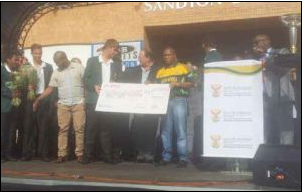 The Baby Proteas defeated Pakistan by six wickets in the final of the world cup.
The Baby Proteas defeated Pakistan by six wickets in the final of the world cup.
It was South Africa’s first victory in this tournament and the third time they reached the final, having been there under Hashim Amla’s captaincy in 2002 and Wayne Parnell’s in 2008.
“This is what we are about as a nation - winning and winning for our people. We can’t ask for more when we talk about the foundation of building a success story for this great nation of the late former President Nelson Mandela,” said Minister Mbalula at an event celebrating the team’s success. The Baby Proteas paraded their trophy in Johannesburg on an open bus.
The Minister thanked the parents of the young cricketers for allowing them to share the moment of glory with their fellow South Africans.
“This is their story. They have a great future ahead of them. Cricket SA and government will look after them. We will never forget what they did for South Africa,” he said.
Asked how they managed to beat their opponents, the team’s captain, Aiden Markram, said: “I think it was just a balance of self-belief and discipline, with each player sticking to our game plan. At the end of the day, we were fortunate enough to be on the winning side.
“We had very good preparations ahead of the tournament but after our first victory, the mood was very good at the camp. It gave us the winning momentum and fortunately, Nthambeleni Gabara this also worked out very well for our team.”
Markram said the team was humbled by the support from the nation. “We never expected this overwhelming support at all and this makes us happy. We appreciate it, as this is one of our great moments in our lives.”
Markram said the bar had now been raised for the team to do even better. “We do feel the pressure … but as players, we will deal with it by ensuring that we divert such pressure by defeating our opponents.”
